Maps & Infographics
Learn more on the Chinese market by browsing our different maps and infographics

The Chinese-style snacks and fast food market thrive due to convenience, affordability, and cultural appeal. According to Qcc (企查查), in the first 11 months of 2023, there were more than 420,000 registered businesses related to snacks and fast food, an increase of 0.5% year-on-year; and there were more than 3.64 million stocks of businesses related to snacks and fast food, an increase of 4.6% year-on-year.
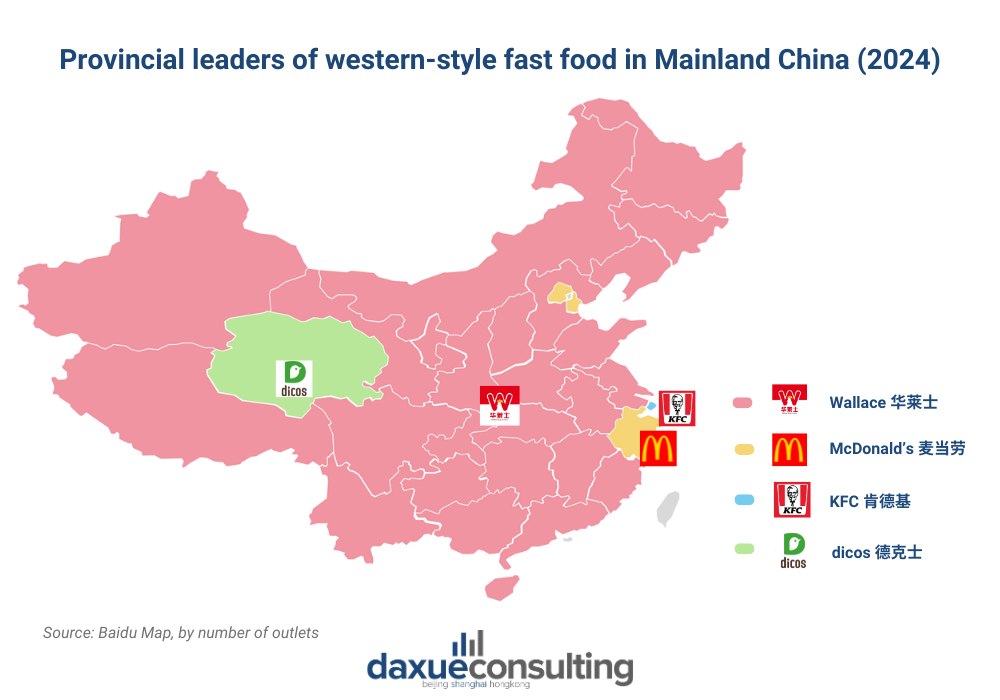
In China, the Western-style fast food market, valued at RMB 231 billion in 2021, marked a 10.4% YoY growth, bouncing back from pandemic-induced setbacks. For instance, Wallace 华莱士, a local brand, dominates with over 20,000 stores by 2022. Affordable options below RMB 40 (USD 5.56) constitute 92% of offerings, driving per capita consumption as East China leads regional

As of August 31, 2023, China’s bubble tea stores rose to 515,000, a 36% annual increase. Moreover, Guangdong, especially Guangzhou and Dongguan, dominates in milk tea shops. Meanwhile, Mixue leads with 36,000 stores nationwide; followed by Good Me (古茗), ChaPanda (茶百道), and Auntea Jenny (沪上阿姨), with 9,001 (as of the end of December 2023), 7,927 (as of the end of December 2023), and 7,297 (as of the end of September 2023), respectively.
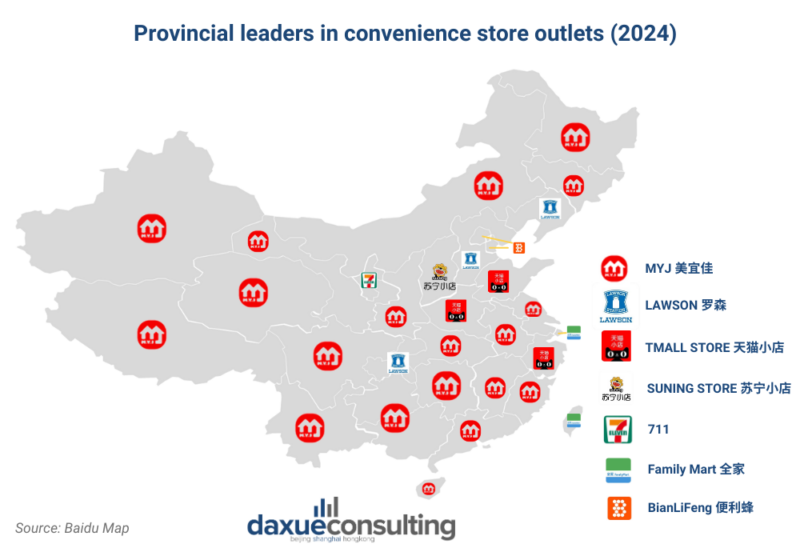
In 2022, China’s convenience store industry, valued at RMB 383.4 billion, grew 9.8% YoY. MYJ美宜佳, the largest chain, headquartered in Guangdong, boasts over 30,000 stores nationwide, surpassing foreign-owned competitors like Lawson罗森 (5,642 stores), 7-Eleven (3,319 stores), and FamilyMart全家 (2,666 stores).
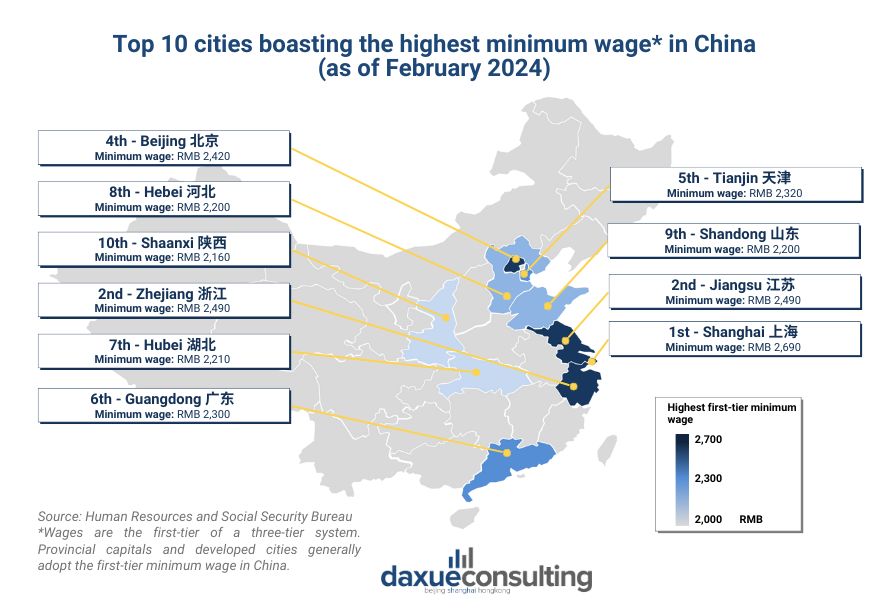
China’s Ministry of Human Resources and Social Security released new minimum wage standards effective January 1, 2024, across provinces and municipalities. 18 regions set the first tier of monthly minimum wage at RMB 2,000 or higher. Shanghai, Jiangsu, Zhejiang, and Beijing lead in standards, reflecting potential shifts in labor policies and economic dynamics. The standards, detailed in “Minimum Wage Regulations,” vary for full-time and part-time workers, with Shanghai setting the national benchmark at RMB 2,690 monthly, emphasizing the nuanced approach to labor regulations in China’s diverse landscape.
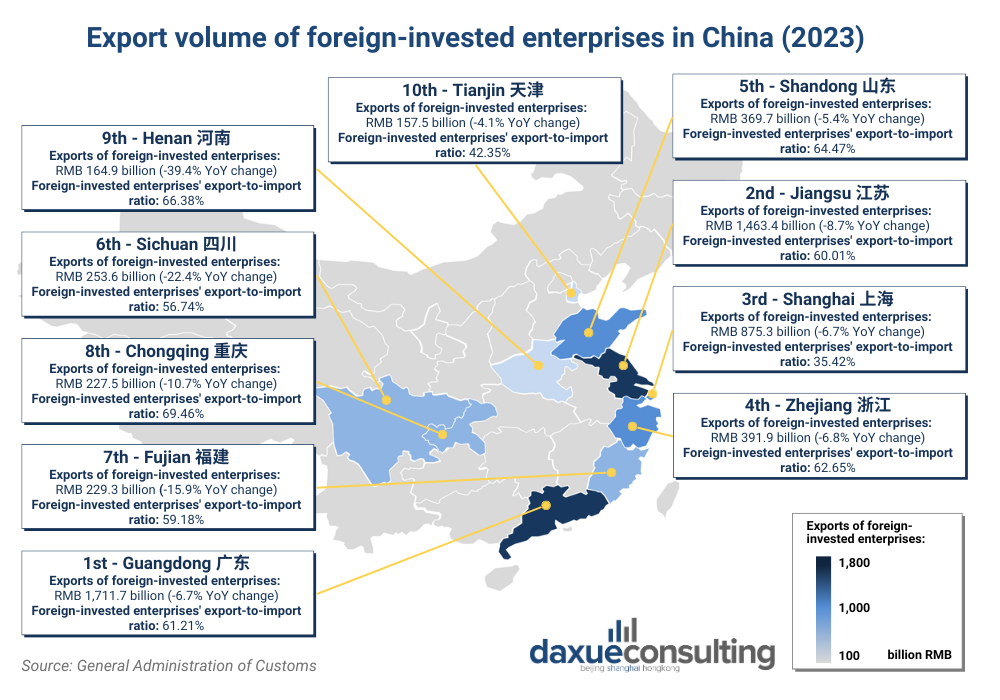
In 2023, China’s foreign-invested enterprises faced a 9.2% YoY decline, collectively exporting RMB 67,884.89 billion, contributing over half to the overall import/export volume. Guangdong and Jiangsu provinces excelled with exports surpassing RMB one trillion, while 22 provinces showed export value ratios exceeding 50%. Qinghai led with 95.13%, contrasted by Tibet’s lowest at 1.55%.

In 2023, cities like Harbin gained global acclaim for their cultural richness, culinary uniqueness, and hosting large-scale events like the Ice and Snow World, making it a sought-after destination. Zibo emerged as a culinary hotspot during 2023’s summer with unique barbecue methods, supported by government initiatives to enhance its popularity. Moreover, Jiangmen, known for hosting the TV series “The Knockout,” and Hangzhou, the 2023 Asian Games host, showcased their cultural appeal. Jay Chou’s concert highlighted Haikou’s musical charm, offering diverse attractions.
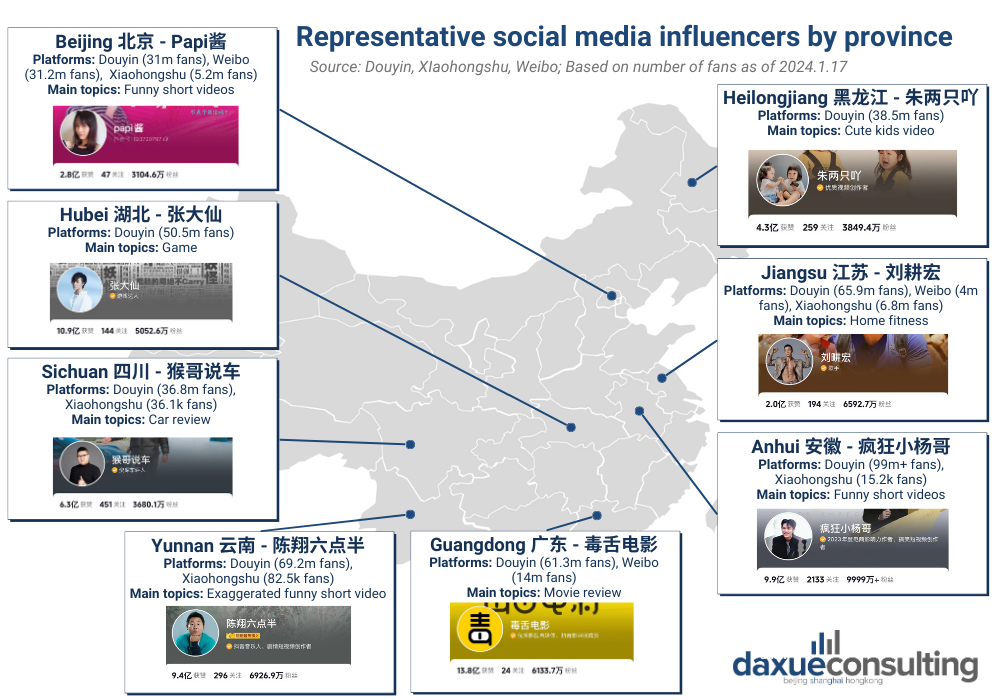
The map presents popular social media influencers across 8 provinces, featuring “Papi酱” from Beijing, a Central Academy of Drama graduate celebrated for her humor and wit in addressing societal and everyday topics through short videos. Meanwhile, in Jiangsu, the well-known fitness coach “刘耕宏” Liu Genghong not only shares professional fitness knowledge but also actively engages in charitable activities, using his influence to promote a positive and healthy lifestyle.
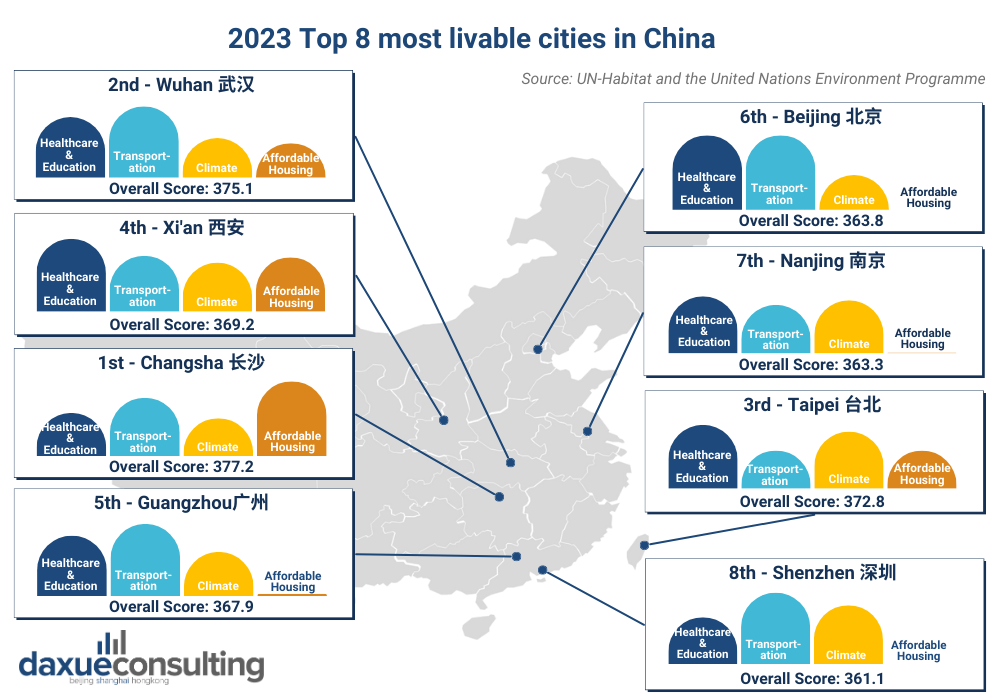
According to the Top 30 Chinese Cities Livability Index 2023 by UN-Habitat and the United Nations Environment Program, Changsha, Wuhan, and Taipei are the top three most livable cities in China. Changsha leads the ranking due to its pleasant climate, well-developed transportation, high-quality healthcare and education, and low pressure on homeownership. Wuhan is recognized for its cultural heritage, efficient urban construction, and ecological protection, while Taipei stands out for its internationalized city atmosphere, comprehensive public services, and relatively low housing prices.
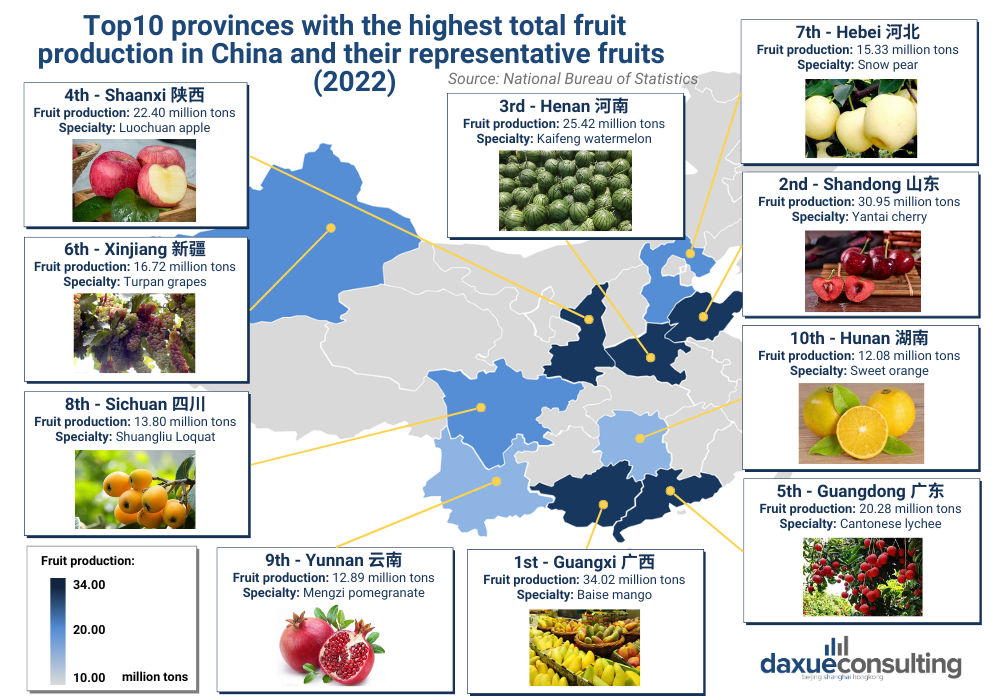
In 2022, China saw a 4.42% YoY increase in fruit production, totaling 312.96 million tons. For which, Guangxi, Shandong, Henan, Shaanxi, and Guangdong were the leading provinces, contributing significantly to the national output. Additionally, China’s fruit trade in 2022 reached 120.82 million tons with a value of 20.483 billion U.S. dollars, majorly driven by exports of apples, citrus, and grapes. Notably, watermelon production dominated the melon products sector, comprising over 70%, with Henan and Shandong leading in melon and fruit production.
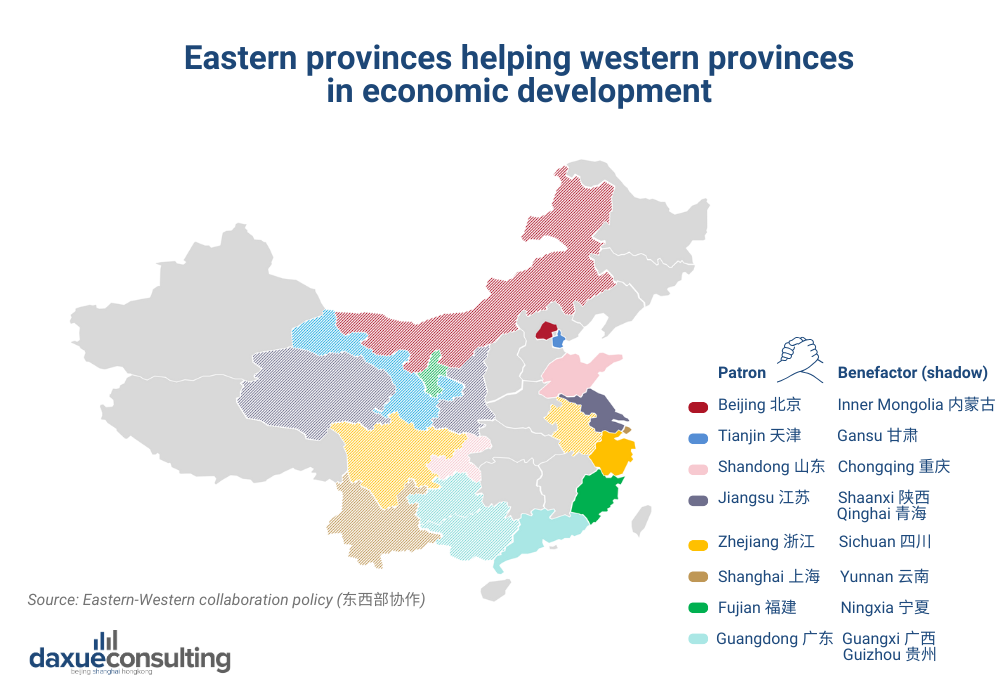
China’s Eastern-Western collaboration (东西部协作) promotes balanced nationwide development by leveraging the strengths of developed eastern provinces to foster economic growth in the west. This initiative includes sharing technology, funds, and expertise across sectors, extending to infrastructure, education, and training for collective investment and synergistic economic progress. The goal is to ensure shared prosperity through collaborative efforts.
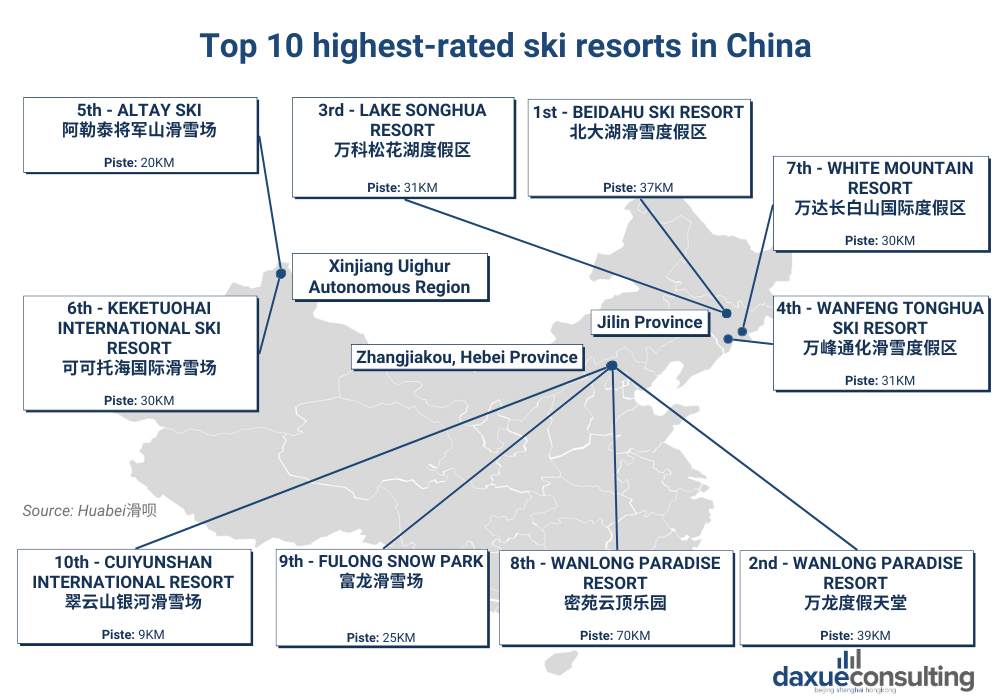
China is witnessing a winter sports revival, with prominent ski resorts in Beijing-Tianjin-Hebei, Xinjiang, and Jilin gaining attention. Fueled by government support and post-2022 Winter Olympics excitement, these regions are experiencing a surge in popularity and substantial investments, transforming them into modern winter sports destinations. The heightened global attention has accelerated infrastructure development, positioning China’s ski resorts as influential players in the worldwide winter sports scene.
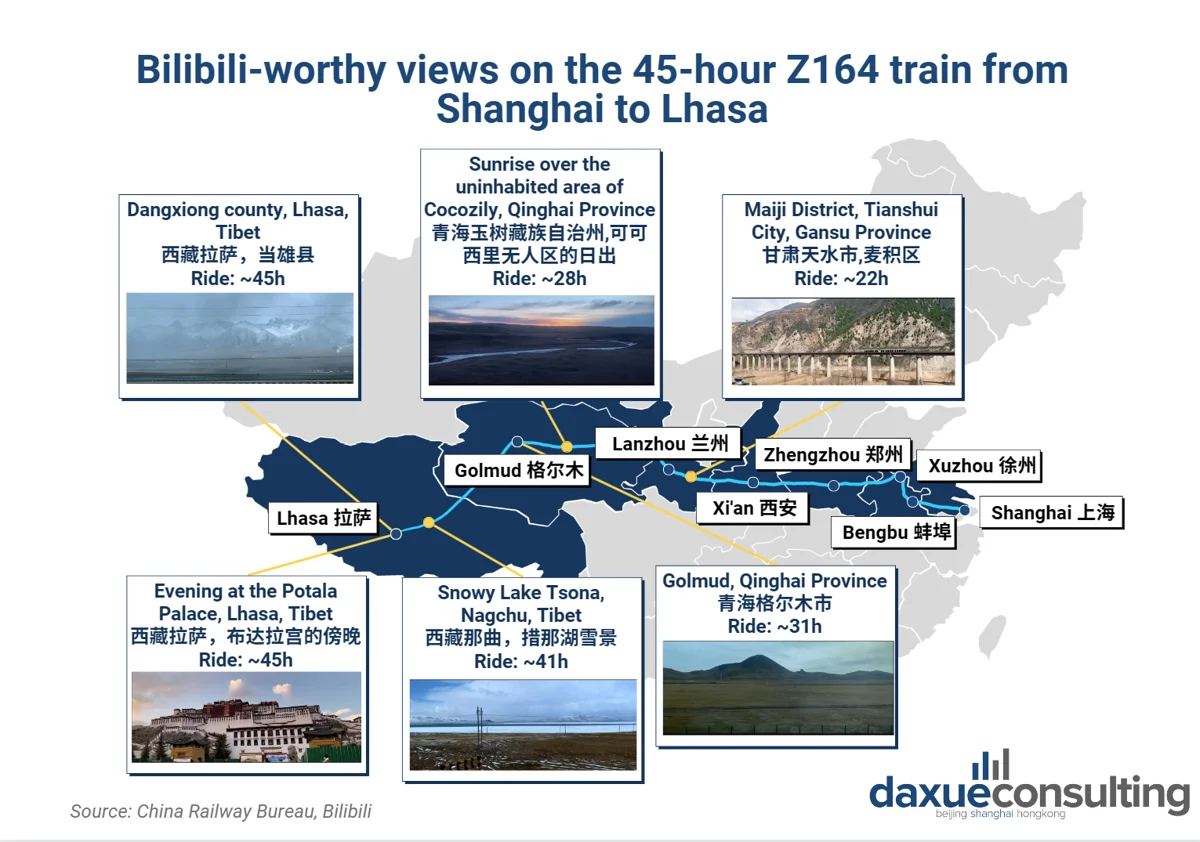
The Z164, a nearly 47-hour direct express train from Shanghai to Lhasa, offers a captivating journey through the provinces of Jiangsu, Anhui, Henan, Shaanxi, Gansu, Qinghai, and Tibet. Its scenic ride showcases China’s diverse landscapes, from the picturesque Yangtze River to cultural relics in central China, Huashan Mountain, Terracotta Warriors in Shaanxi, and the awe-inspiring Qinghai-Tibet Plateau.
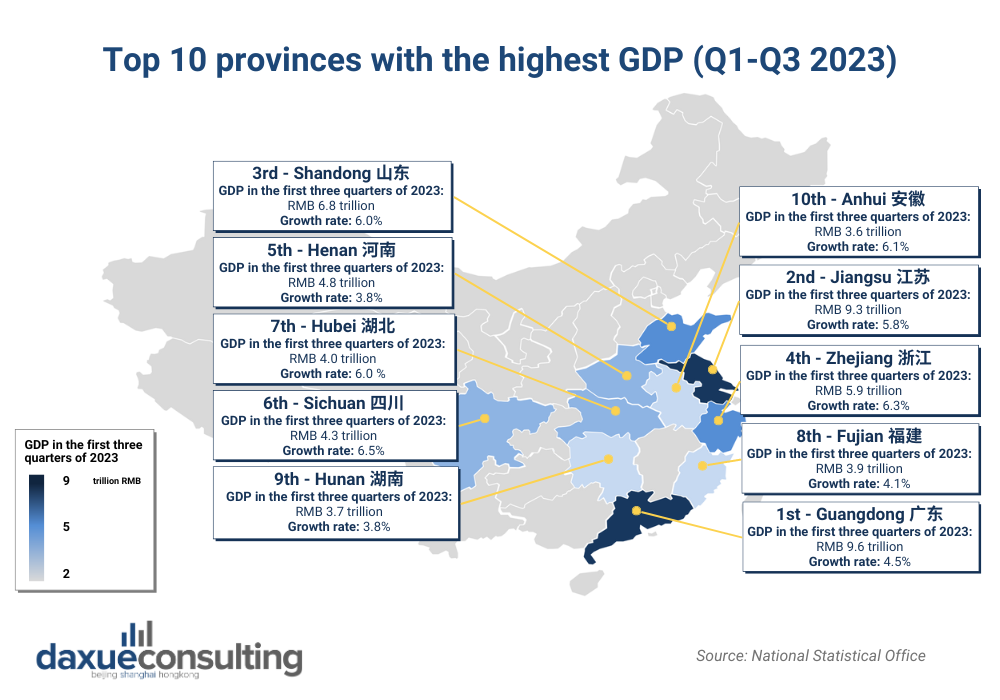
In the first three quarters of 2023, Guangdong, Jiangsu, and Shandong topped China’s GDP ranking whilst Tibet, Hainan, and Inner Mongolia led in GDP growth. Tibet’s success is driven by tourism, government support, and infrastructure development. Meanwhile, in contrast, Shaanxi and Heilongjiang, face slower growth due to industrial challenges, resource dependence, and global economic shifts.
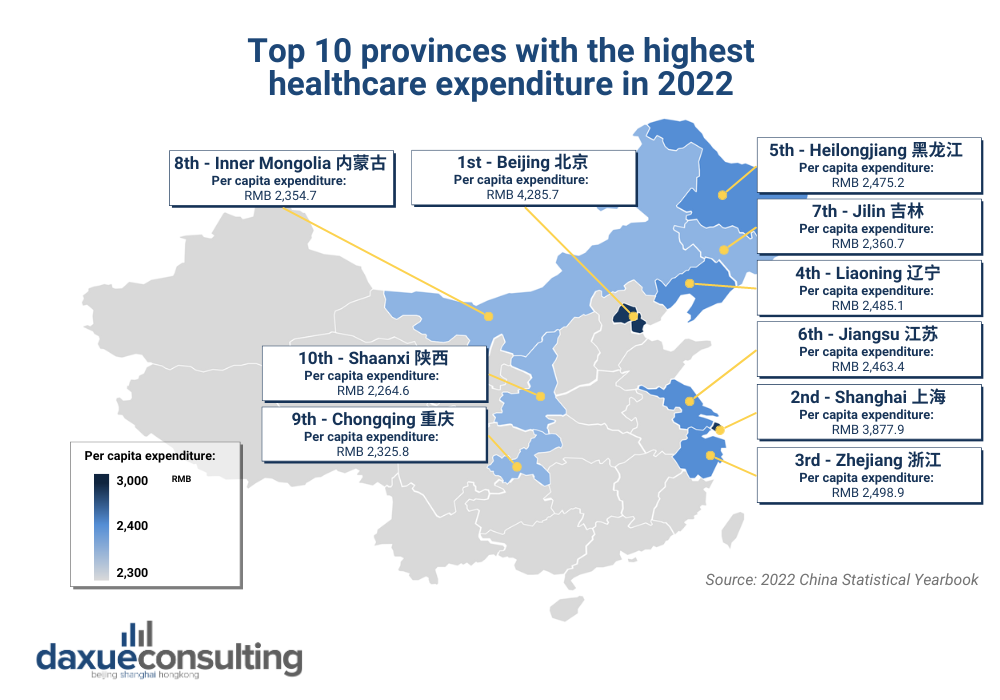
In 2022, China’s average disposable income rose by 5.0% to RMB36,883, with healthcare spending reaching RMB2,120, constituting 8.6% of overall consumption. Notably, regional variations indicate higher healthcare expenditures in economically developed Eastern provinces. For instance, the economic growth contributes to an increased demand for high-value dental items, propelling the expansion of the oral healthcare services market.
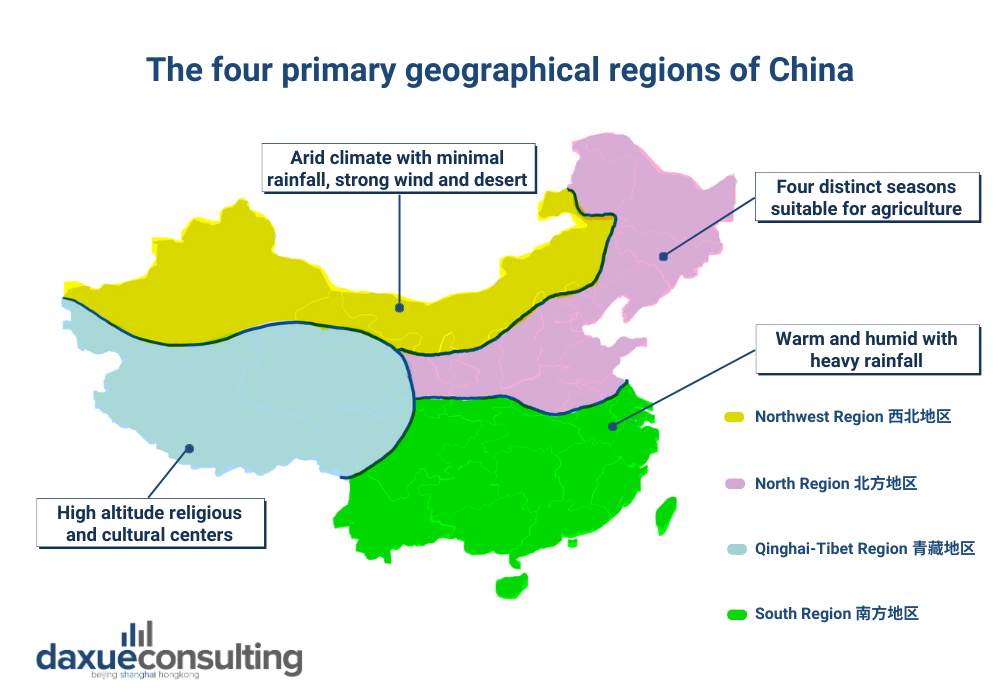
China’s geographical regions, including the Northwest, Northern, Qinghai-Tibet, and Southern areas, exhibit diverse characteristics. In the Northwest, marked by grasslands and deserts, the focus is on animal husbandry, energy, and mining. Moving to the North, deciduous forests foster agriculture and heavy industries. Meanwhile, the Qinghai-Tibet region, characterized by high altitudes and limited settlement, holds cultural significance. Finally, the Southern region, situated in the southeast, specializes in light industries and stands out as a key tourist destination with attractions like water towns and scenic mountains.

Luckin Coffee is China’s largest chain coffee brand. Established in 2017, it targets the mid-range market through online marketing and value-for-money offerings. In contrast, Starbucks, positioning itself as a premium brand, faces increased competition from local brands in China. Meanwhile Lucky Cup, operated by Mixue Ice Cream & Tea, dominates market share in Henan and Ningxia provinces with its mid-to-low-range pricing strategy and strategic expansion from third and fourth-tier cities.

According to estimations from the China Fishing Association, approximately 140 million people in China engage in fishing at least four times a year. Among them, individuals under 18 make up 12%, those aged 18-24 comprise 10%, and those aged 25-44 make up the largest group at 46%, indicating their significant role in the fishing community.
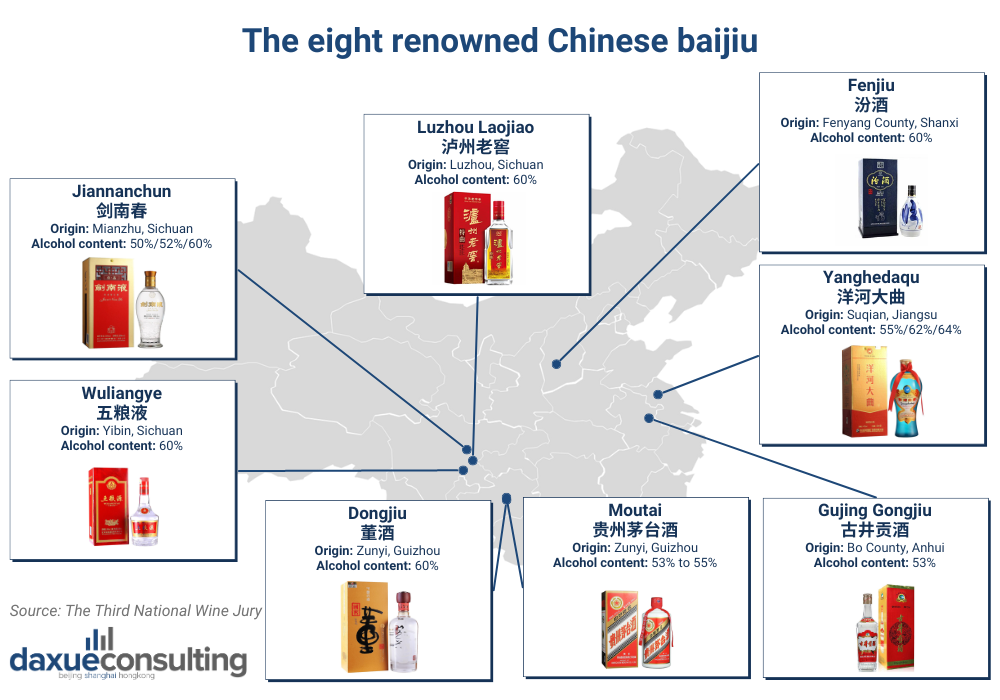
Baijiu is a type of traditional Chinese distilled spirit known for its strong aroma and unique taste. It is brewed from sorghum, rice, wheat and other grains, and then distilled. It has a long history in China and is often considered the country’s national liquor. These eight famous Chinese liquors each have their own unique features and are recognized as some of the best examples of Chinese liquor-making art.
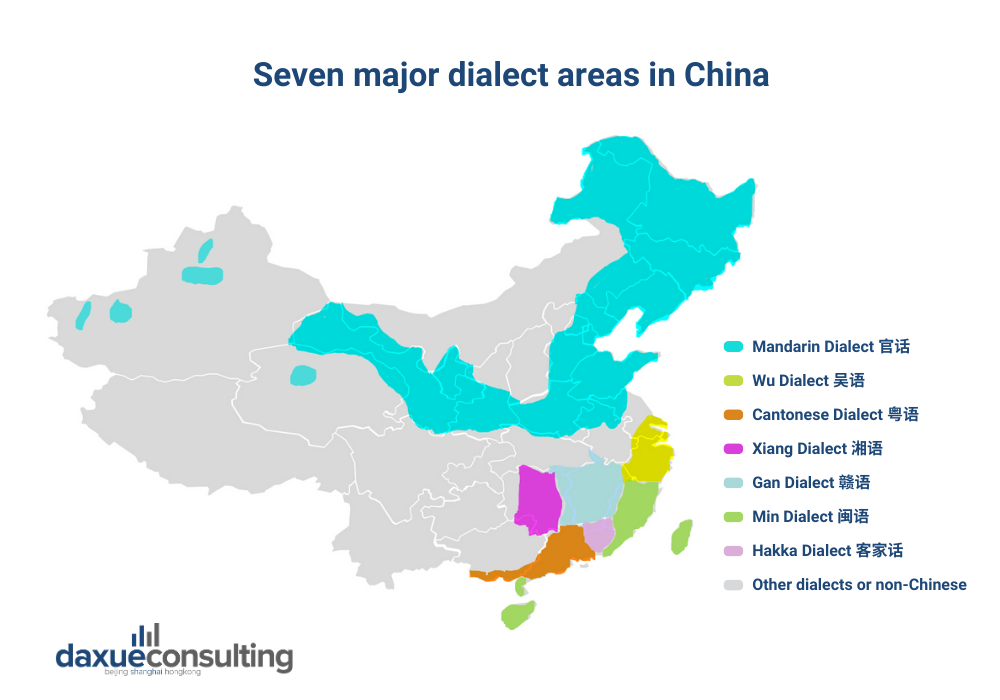
Chinese can be broadly categorized into seven major dialect groups, often referred to as “dialect areas.” Each dialect area has its unique characteristics and differences in pronunciation, grammar, and vocabulary. These seven major dialect groups are often referred to as “fāngyán” (方言) in Chinese, meaning “regional languages” or “topolects.” While Mandarin is the official standard language, the dialect groups listed above represent significant linguistic diversity within China.

The “Three Mountains and Five Great Mountains” (“三山五岳”) comprise a collection of China’s most renowned and beloved mountainous treasures, each boasting its distinct allure. From Mount Huang’s (黄山) stone peaks to Mount Tai’s (东岳泰山) medicinal heritage, they are cherished treasures. These mountains and scenic spots are located in different parts of China and vary in unique features that attract tourists for their beauty and scientific value.
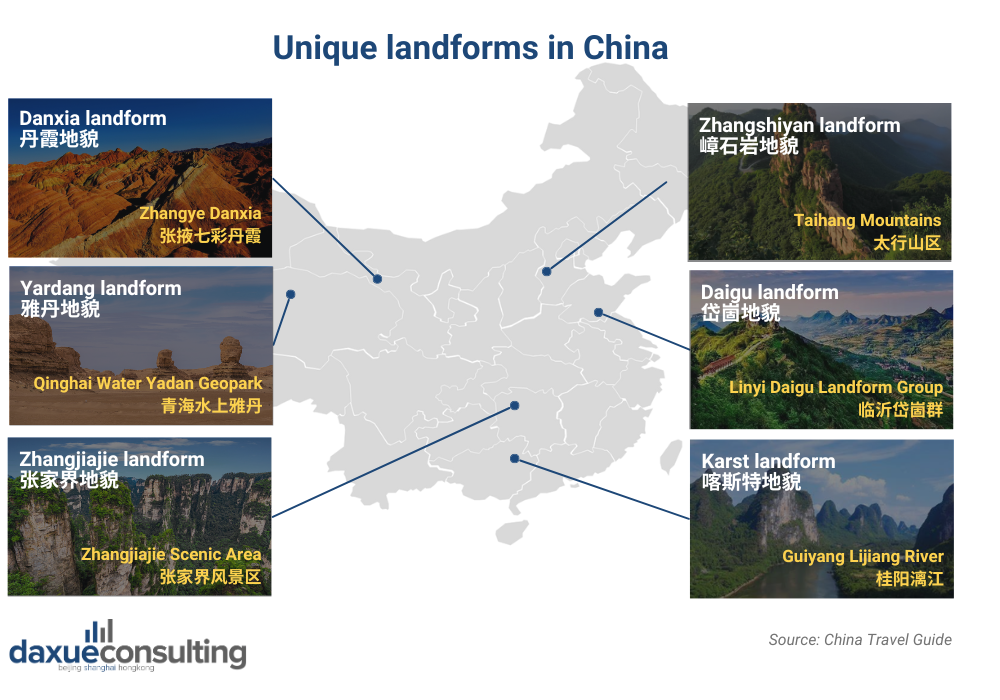
China’s six unique geological landforms, including Danxia, Karst, Yardang, Zhangjiajie, Zhangshiyan, and Daigu, are distributed across different regions of the country. These diverse landscapes not only showcase China’s natural beauty but also attract tourists and researchers from around the world, offering significant opportunities for exploration and scientific study.
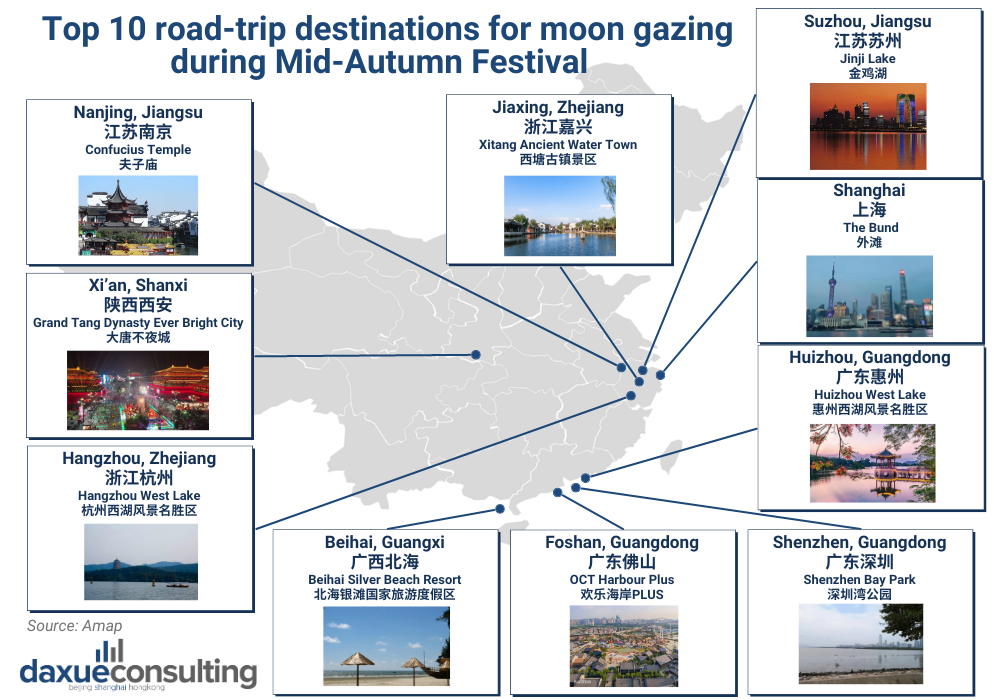
Mid-Autumn Festival is a cherished traditional Chinese festival. It is a time for family reunion and relaxation, often enjoyed with loved ones beneath the luminous moon. In 2023, Amap, a leading provider of mobile mapping and navigation app, has forecasted the top 10 most popular road-trip destinations for moon-gazing during the festival.
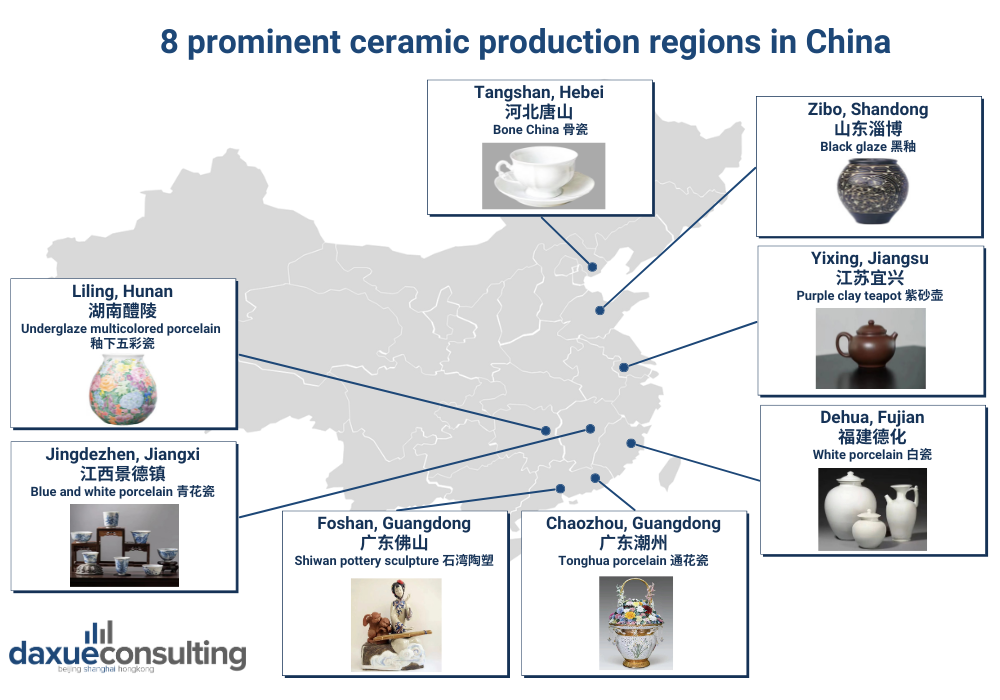
China has a rich history of porcelain production, with notable milestones like Tang Dynasty’s white porcelain. Today, eight renowned regions specialize in various ceramic styles, like Jingdezhen for blue and white porcelain and Yixing for purple clay teapots, showcasing unique traditions passed down through generations.

Citywalk has become a major trend in Chinese media due to its emphasis on spontaneous and immersive urban exploration. In the first half of 2023, searches for Citywalk increased by over 30 times, and it was tagged in more than 480,000 notes on Xiaohongshu, reflecting its popularity. Citywalk meets the current travel preferences, catering to young travelers who are seeking unique, relaxing, and immersive local experiences, as well as proximity and culinary options.

China’s diverse landscapes offer popular hiking destinations such as Tibet, Xinjiang, Yunnan, and Sichuan. Yunnan boasts trails through forests and mountains like Meili Snow Mountain and Tiger Leaping Gorge. Sichuan offers treks in places like Jiuzhaigou and Daocheng Yading, while Tibet features sacred peaks like Mount Kailash, and Xinjiang has trails around the Tianshan Mountains and Kanas Lake.
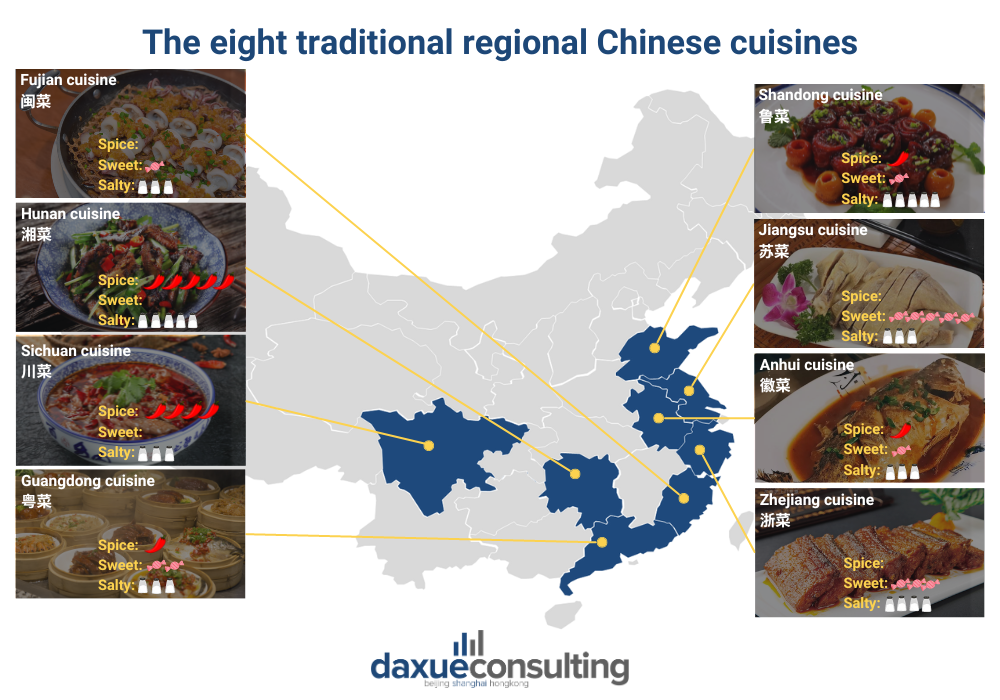
Traditional Chinese cuisine is a rich tapestry woven from eight distinct culinary traditions, each influenced by China’s diverse landscapes and cultures over centuries. These traditions range from fiery and spicy Sichuan cuisine to delicate and balanced Cantonese cuisine, celebrating bold flavors, elegant presentation, and a harmonious blend of tastes and textures across various regions. Together, they offer a gastronomic voyage that encapsulates the essence of China’s culinary diversity.
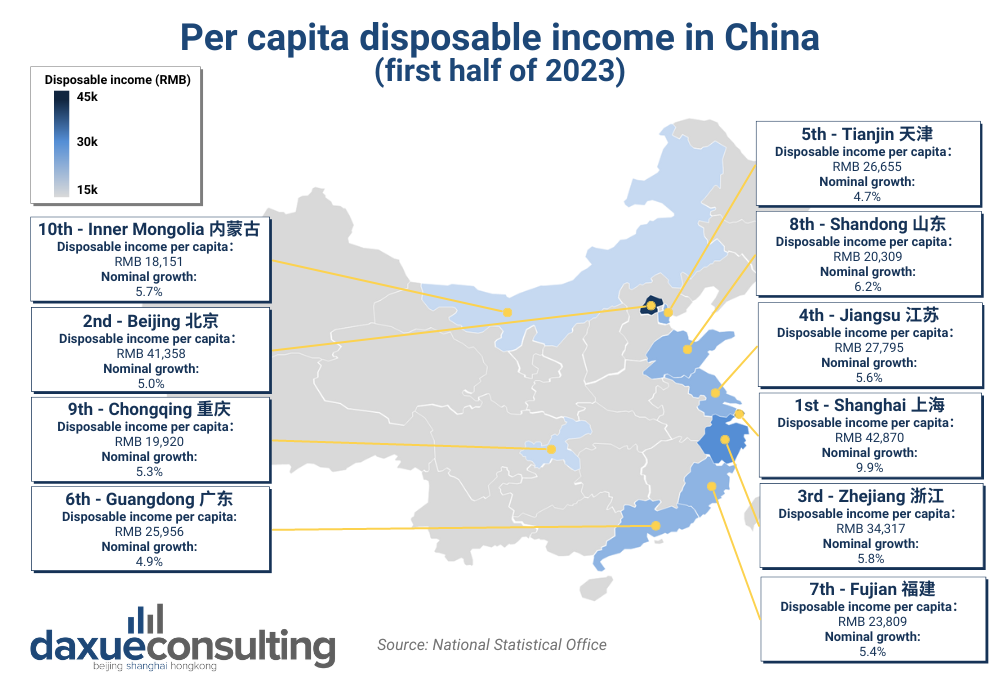
In the first half of 2023, China’s average disposable income per capita rose by 6.5% nominally (5.8% adjusted for inflation) compared to the previous year, reaching 19,672 yuan. Urban areas saw a 5.4% nominal growth, with an average of 26,357 yuan, while rural areas experienced a 7.8% nominal increase, with an average of 10,551 yuan.

China leads globally in fruit cultivation due to its expansive and diverse land area, with Guangxi province standing out as the top fruit producer, contributing significantly to poverty alleviation through its fruit industry. Meanwhile, Yunnan province demonstrates remarkable growth in both fruit cultivation area and output, surpassing the national average growth rate.

Chinese welfare lotteries have alleviated social welfare gaps, aiding vulnerable groups and easing government burdens. Its sales have surged due to economic growth and rising incomes, peaking at RMB 224.556 billion from 2015 to 2018. However, a decline followed in 2019-2021 due to an internet lottery ban and the pandemic. Sales rebounded to RMB 136.3 billion by Nov 2022, with Guangdong, Zhejiang, and Shandong leading in sales.
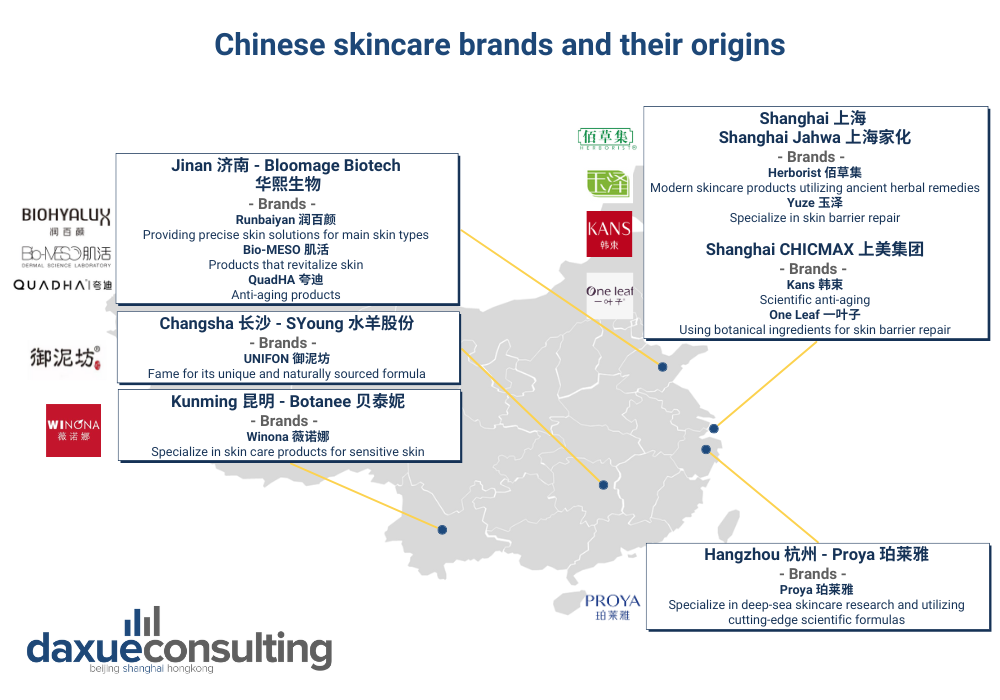
Chinese skincare brands have seen remarkable growth over the past two decades. Companies such as Shanghai Jahwa and Proya achieve significant revenue milestones. There is also a rising trend in the skincare category which emphasizes specialized and scientific products. Thus, brands like Winona which focus on efficacy-based skincare have achieved impressive revenue figures.
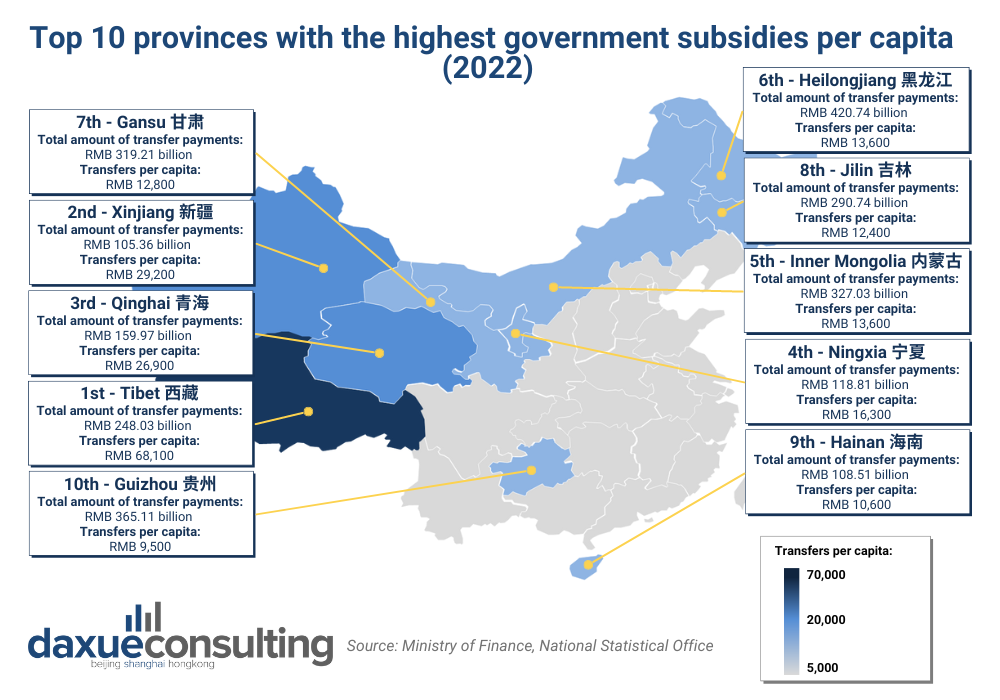
China’s “transfer payment” policy redistributes fiscal revenues from wealthier regions to less developed areas through the central government, mainly for welfare programs. Tibet ranks first in receiving 68,100 yuan per capita (USD 9,549) in transfer payments, followed by Xinjiang and Qinghai. In 2023, the central government plans to allocate over 10 trillion yuan (USD 1.4 trillion) in transfers to promote balanced regional development.
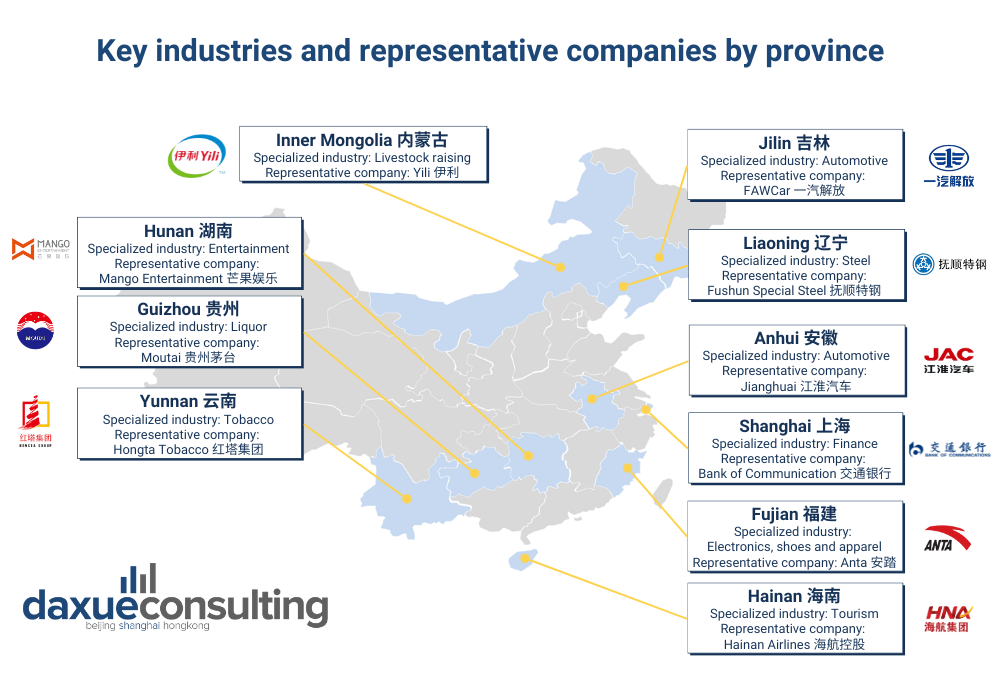
Eastern coastal provinces of China have well-developed industrial chains and advanced production technologies, such as electronics and telecommunications. Meanwhile, central provinces have more diverse secondary industries, such as mining and iron and steel, due to their rich natural resources.

The revenue from fixed Internet broadband access business in China increased by 7.1% in 2022, reaching 240.2 billion yuan. Moreover, the eastern region had the highest proportion of users, at 17.7%. This is because the region is home to China’s most developed cities, such as Beijing, Shanghai, and Guangzhou. These cities have a higher concentration of businesses and consumers, which is driving the demand for fixed Internet broadband access.
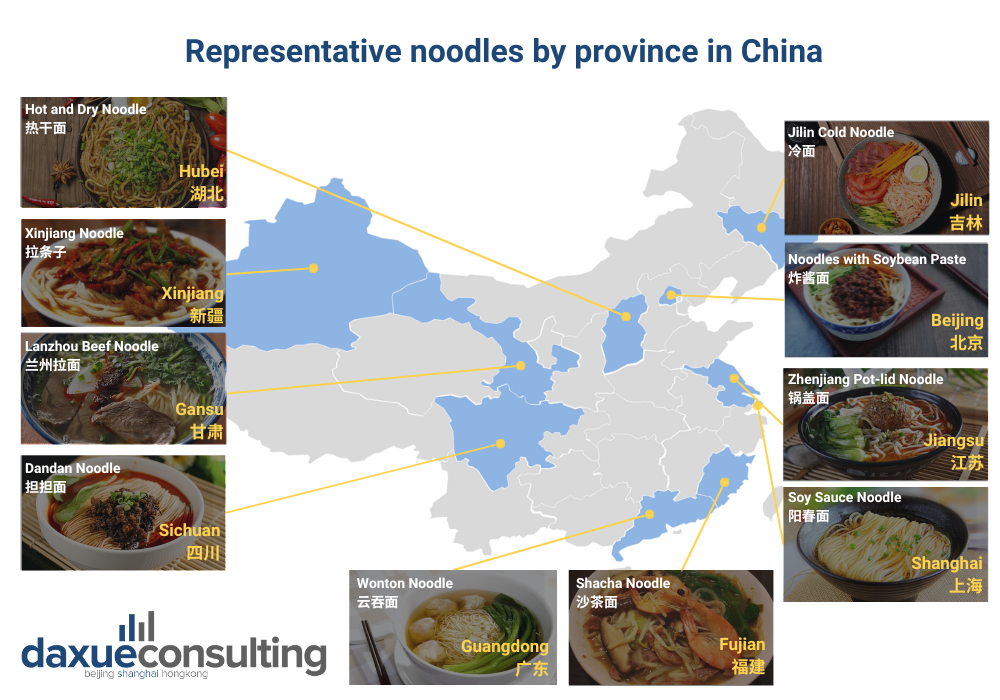
Chinese culinary traditions are divided by the preference for rice in the south and noodles in the north. However, it’s important to note that local noodle specialties can be found throughout the entire country. Wonton Noodle is a popular dish in Guangdong, featuring oiled wontons and egg noodles in hot soup, while Hot and Dry Noodles from Hubei Province are known for their alkaline water-based noodles and diverse range of ingredients.
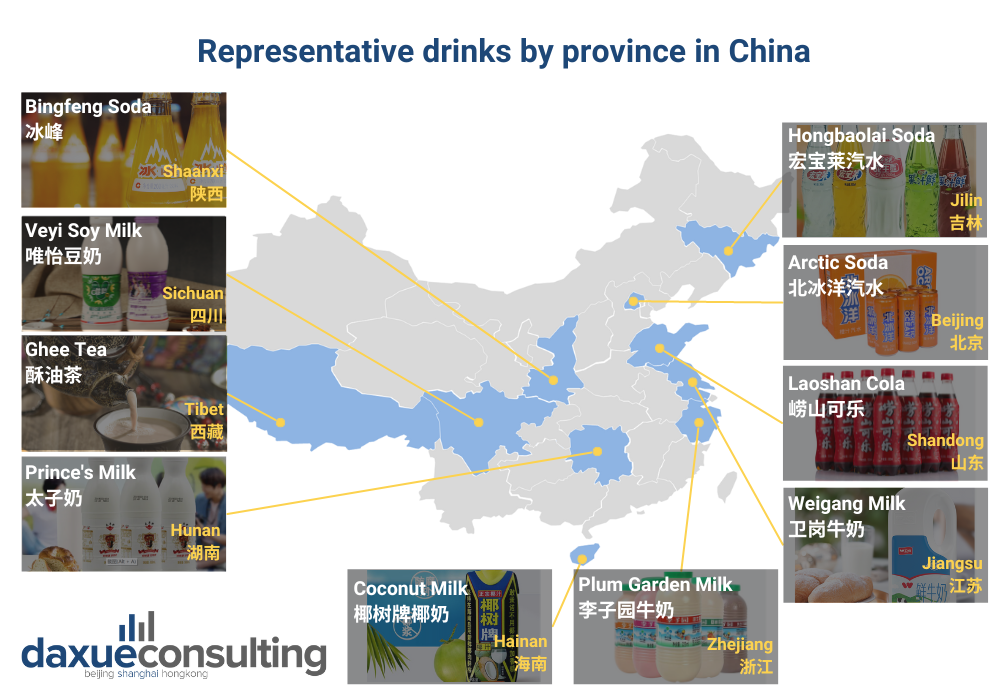
Each Chinese province has its own specialty drinks, ranging from soft drinks to milk, which are predominantly sold exclusively within the province. For instance, Shaanxi Province stands out for its distinctive orange-flavored soda, “Bingfeng soda,” often recommended to international tourists visiting Xi’an along with meat buns and steamed cold noodles.

China’s densely populated cities are mainly concentrated in the Yangtze River Delta, Pearl River Delta, Beijing and Tianjin. Pearl River Delta being the most densely populated region due to the transfer of manufacturing industries and foreign investment. At which, Shenzhen stood out as the most crowded, accommodating over 7,000 individuals per square kilometer.
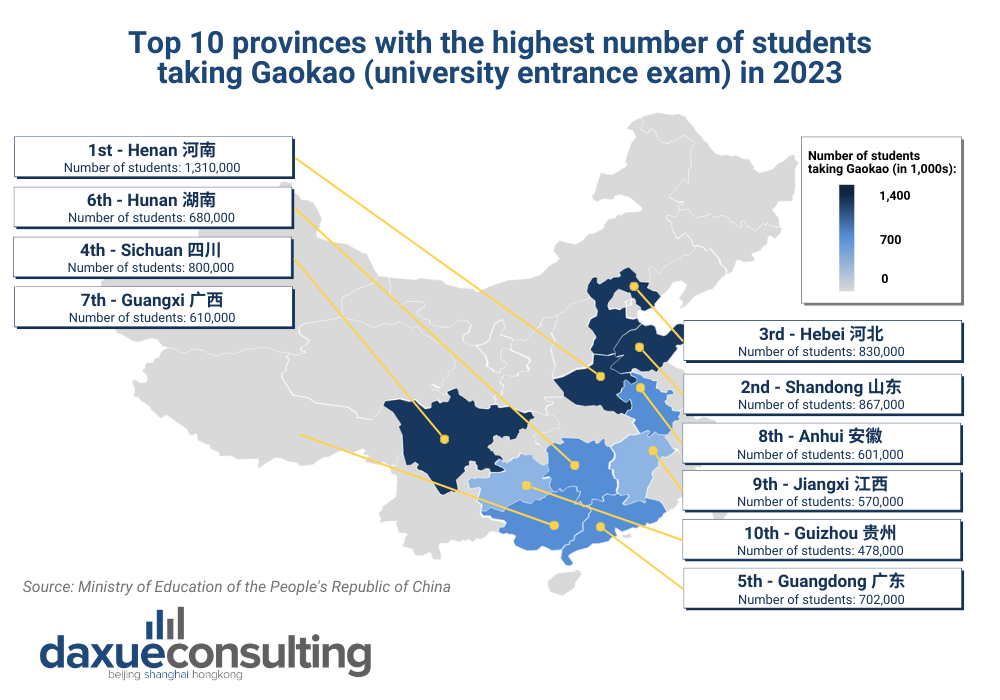
The National College Entrance Exam (Gaokao) was just held in China, with 12.91 million candidates registering this year, an increase of nearly 1 million from 2022. The exam remains an important pathway for individuals in less economically developed regions to improve their future prospect.
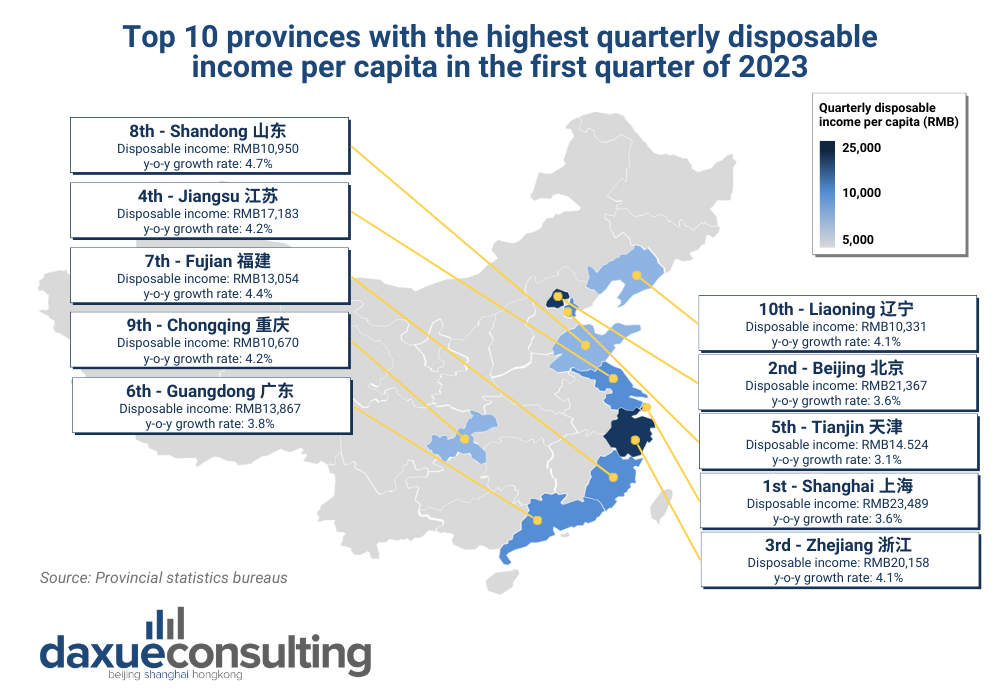
China’s national quarterly disposable income per capita in the first quarter of 2023 increased by 5.1% to 10,870 yuan, with urban residents earning 14,388 yuan (4.0% yoy increase) and rural residents earning 6,131 yuan (6.1% yoy increase). In terms of consumer spending, the largest portion of expenditure in the first quarter of 2023 was on food, tobacco, and alcohol, accounting for 31.6% of per capita consumption expenditure. This represented a 2.1% increase compared to the previous year.
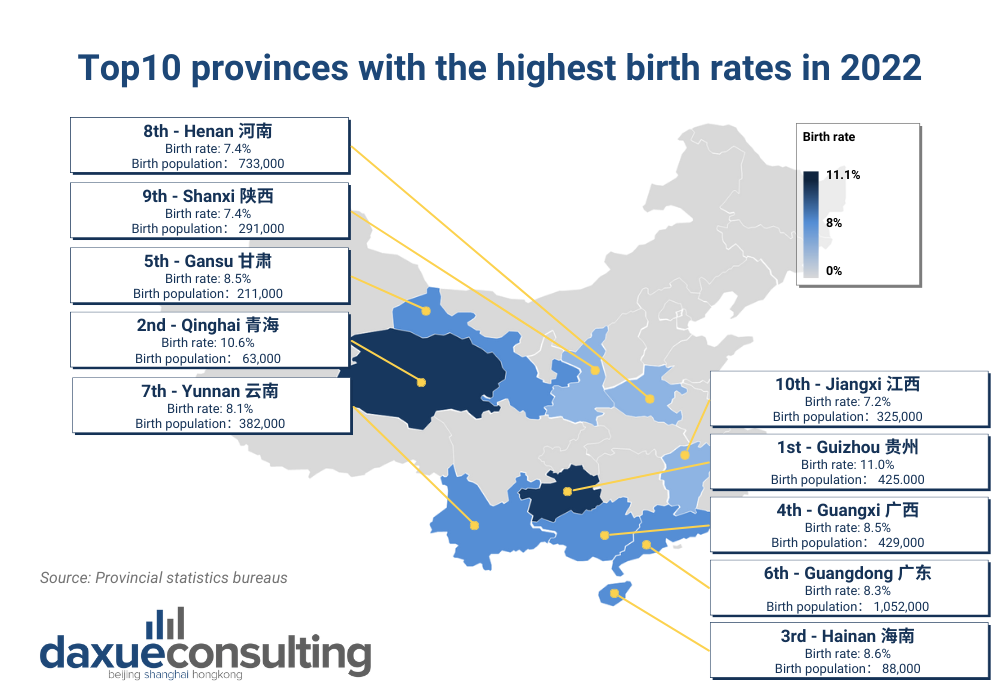
In 2022, China’s population experienced its first decline in 61 years, with a negative growth rate of -0.6%. Only two provinces in the Western region, Guizhou and Qinghai, had a birth rate exceeding 10%. Whilst economically less developed areas generally had higher birth rates, Guangdong province, which ranked among the top 10 in terms of GDP nationwide, had the highest number of births due to an influx of young people from outside the province.

5.20 originated from a song by Fan Xiaoxuan, and with the influence of Internet culture, 5.20 and 5.21 have become a popular and unique Valentine’s Day in China, especially among the younger generation. Brands often release limited edition packages to cater to couples celebrating this festival, taking regional trends and dialects into consideration.
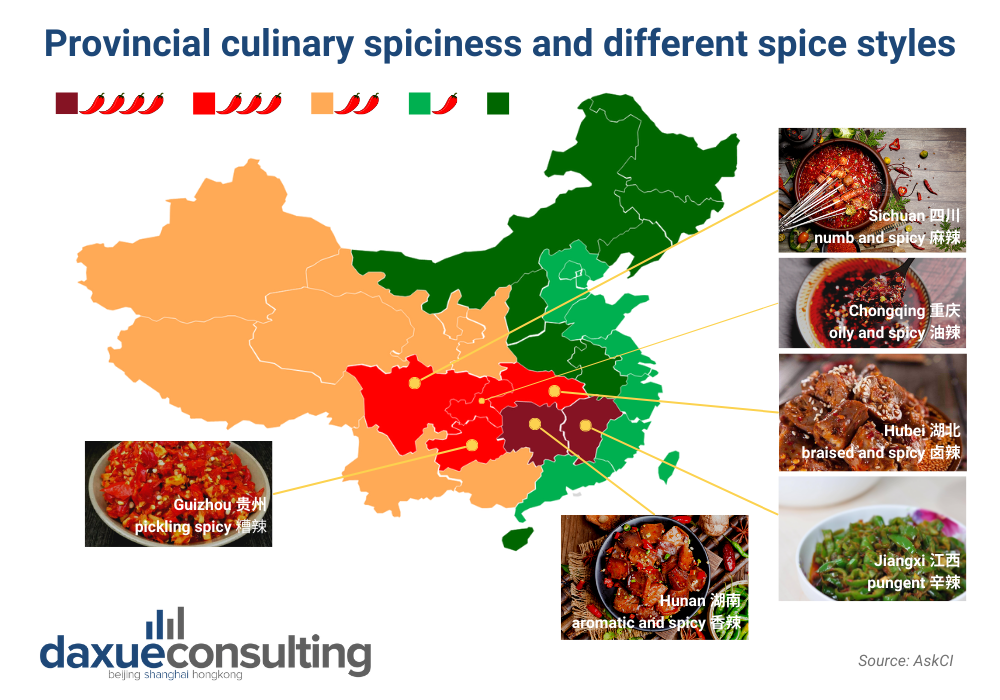
China is the largest producer and consumer of chili peppers, with an annual output value exceeding 70 billion yuan. Provinces like Hunan, Guizhou, Jiangxi, Hubei, and Sichuan are known for their spicy cuisine, with Guizhou featuring a pickling spicy flavor and Sichuan emphasizing a numb and spicy sensation in their dishes.
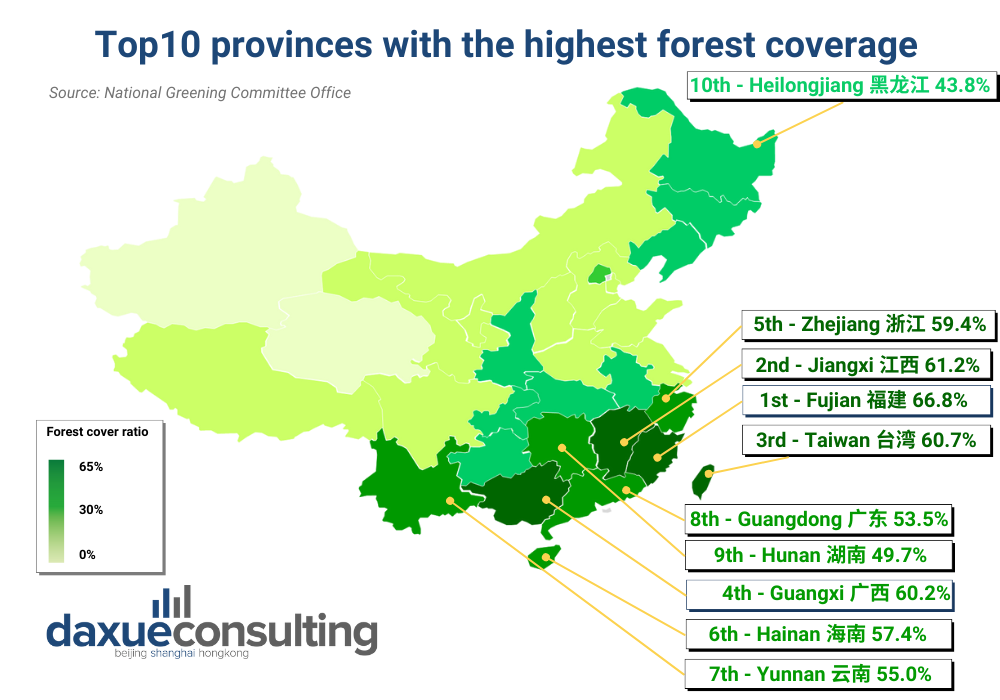
China’s 2022 Land Greening Status Bulletin showed successful afforestation efforts, resulting in a 24% forest coverage rate with 231 million hectares of forest. Provinces in the Southeast and northeast had the highest forest cover due to favorable environmental conditions.
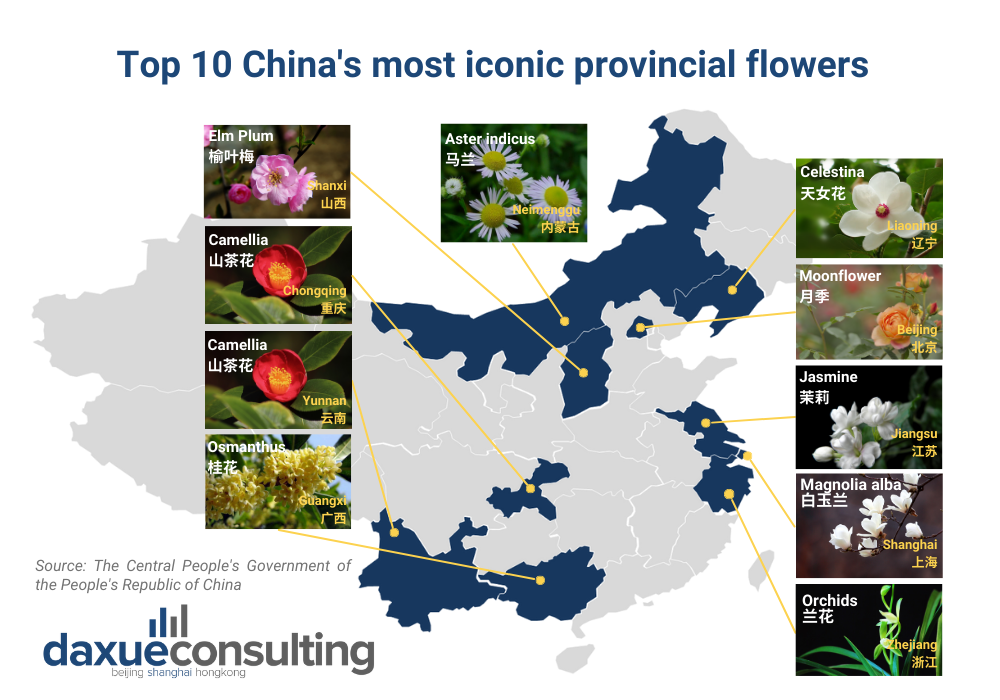
The provincial flowers are chosen based on their prevalence in this region and its ability to represent the qualities and image of the provincial capital city. For instance, Beijing’s provincial flower is the Moonflower which has a long history of cultivation and culture in China. Meanwhile, both Chongqing and Yunnan province have chosen Camellia as their provincial flower which enjoys a symbolic significance in the country.
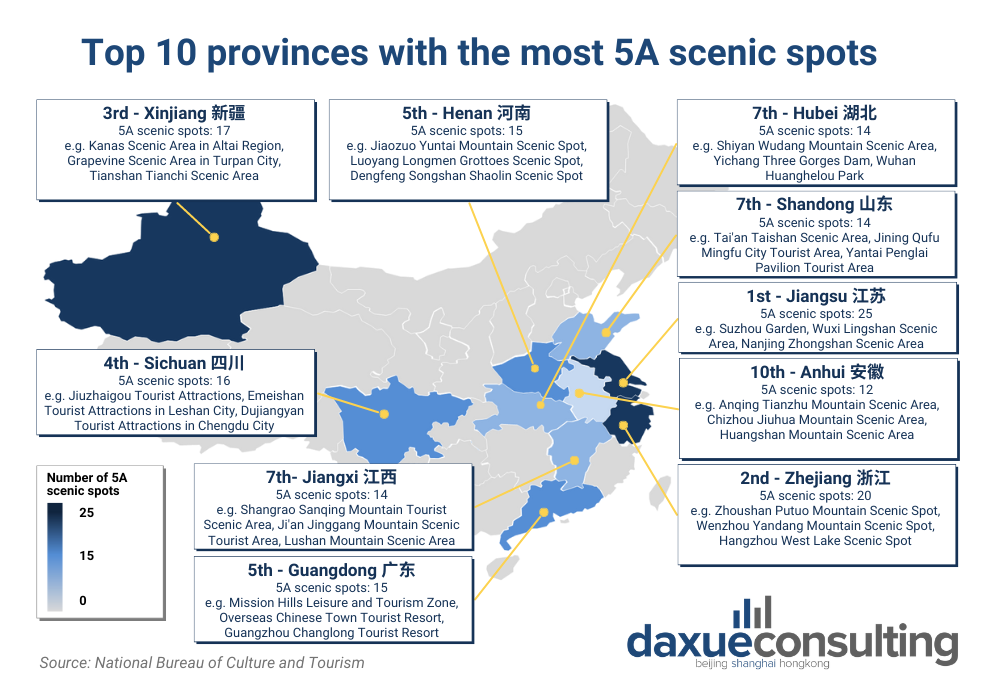
China has 318 5A-rated scenic spots, with Jiangsu and Zhejiang provinces having the highest number at 25 and 20 respectively. These provinces have geographical, historical and economic advantages that contribute to their high number of top-rated scenic areas.
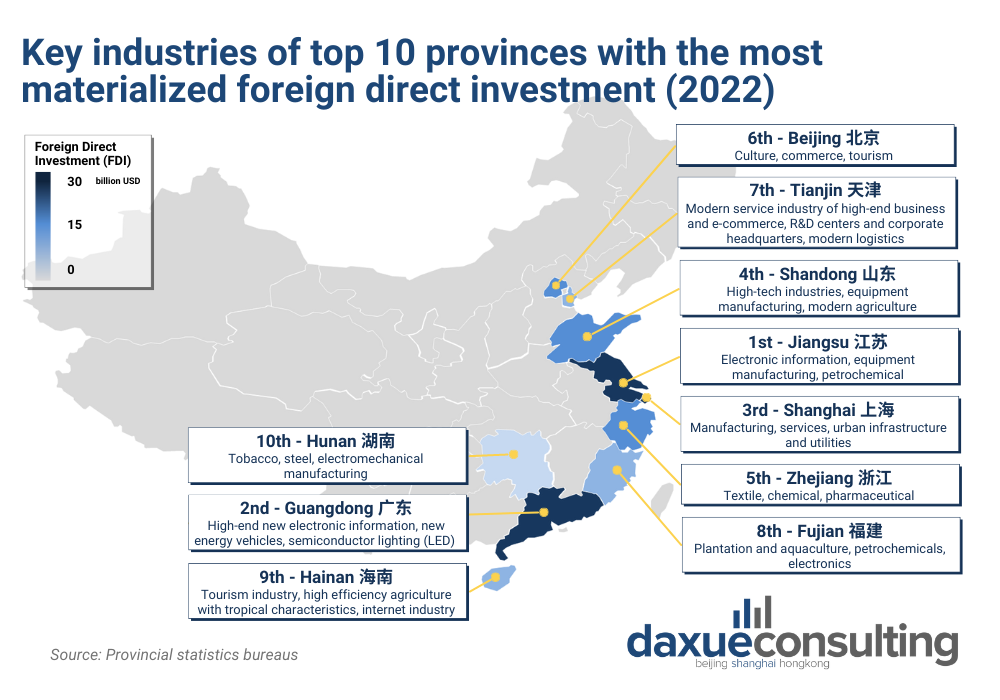
Most of the provinces with high materialized foreign direct investment are located close to the eastern coast of China and have a higher base of industrial efficiency than inland areas. Jiangsu province received the most materialized foreign direct investment in 2022 with dominant industries including electronic information, textile and pharmaceutical industry.
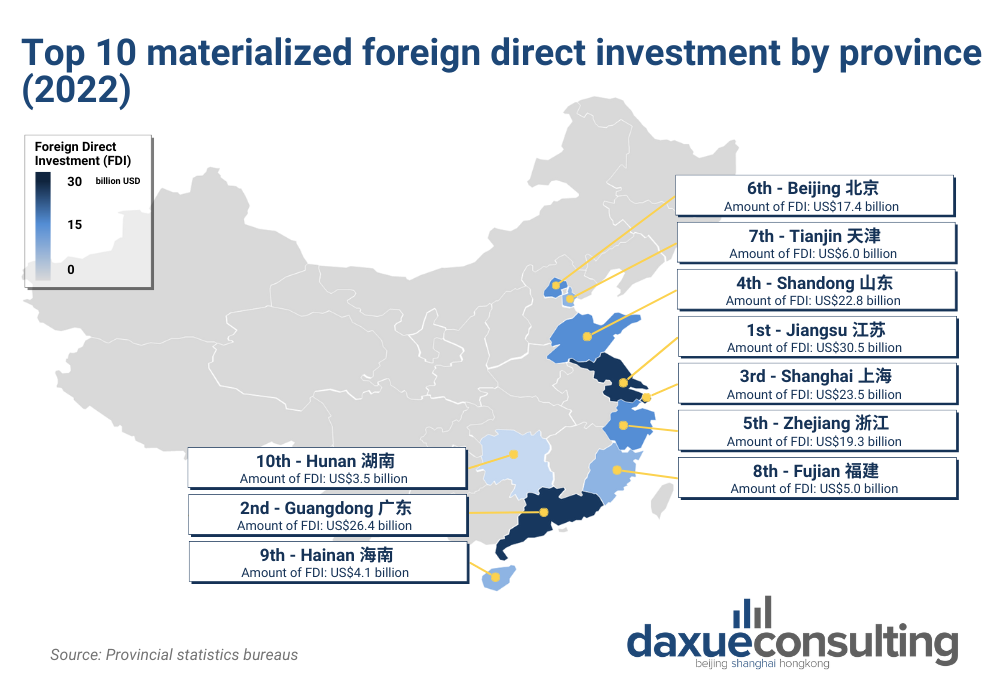
The Ministry of Commerce’s latest data showed that China’s materialized foreign investment in 2022 reached US$189.131 billion in 2022. The eastern region of China, which comprises cities such as Beijing, Tianjin, Hebei, Shanghai, Jiangsu, Zhejiang, Fujian, Shandong, Guangdong, and Hainan, remains the primary area for foreign investment absorption, accounting for 84.4% of the country’s FDI.

China’s GDP in 2022 increased by 3% to reach RMB 121 trillion (US $17.6 trillion), maintaining its position as the second largest economy globally. Guangdong province remained the top-performing region for the 34th year. Meanwhile, Fujian province experienced growth in high-tech, manufacturing, tourism, and clean energy industries.
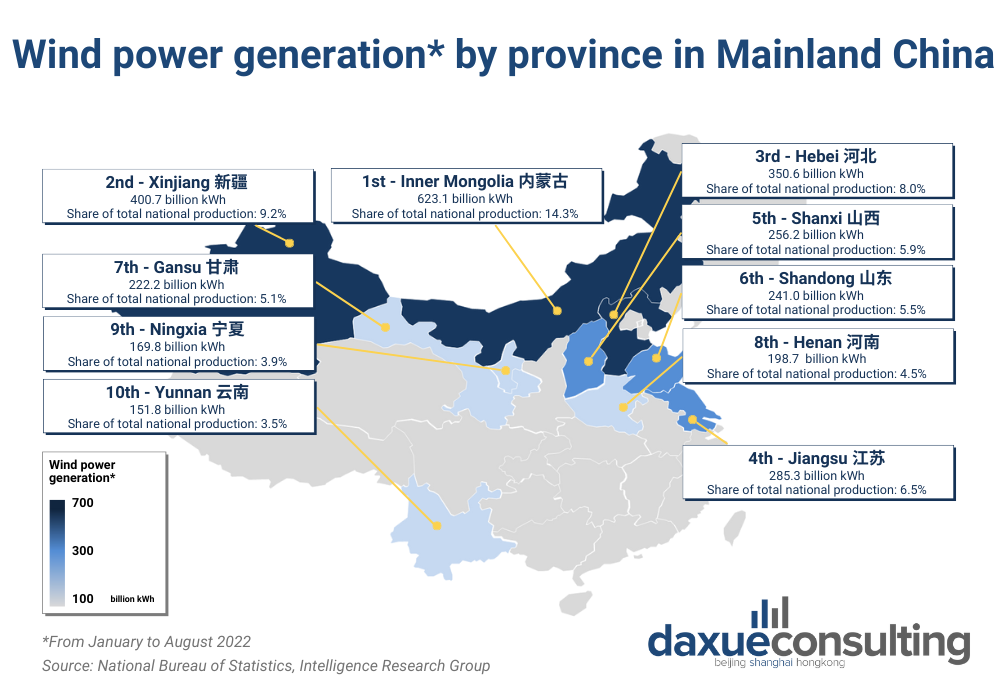
China is a global leader in wind power generation, with a cumulative installed capacity of over 300 million kWh by the end of 2021 and an impressive average utilization rate of 96.9% in 2021. Inner Mongolia benefits from vast land plains and plateaus, which allow for unobstructed airflow, making it an ideal location for wind power generation.
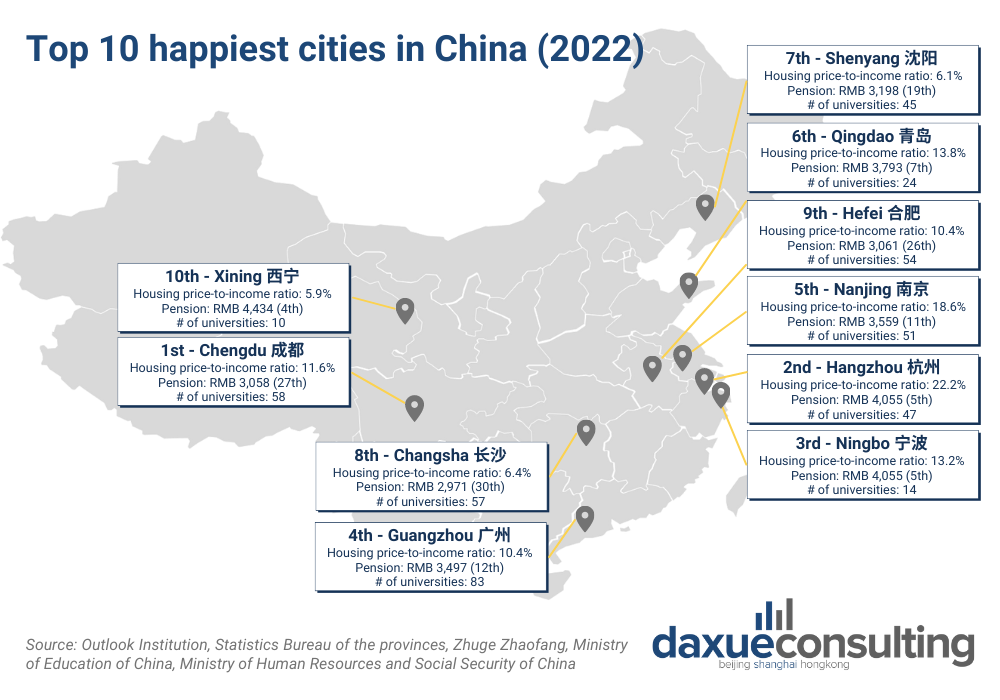
A collaboration between the National Bureau of Statistics and CCTV resulted in a survey of China’s top ten happiest cities based on the citizens’ happiness index. These cities offer ample university education resources, affordable housing, and decent pensions, making them ideal for young people, middle-aged citizens, and the elderly. Chengdu was the most searched city during the 2022 college entrance examination due to its excellent education resources and cost-effectiveness, cultural diversity, and scenic nature.

According to the “National Comprehensive Three-dimensional Transportation Network Planning Outline”, there are 7 cities in the first echelon, which belong to international hubs: Beijing, Tianjin, Shanghai, Guangzhou, Shenzhen, Chengdu, and Chongqing. Besides, nine provinces have over 2,000 km of high-speed rail, led by Guangdong, Anhui, and Shandong. Despite supply chain issues and geopolitical tensions, China’s container throughput at national ports increased by 4.7% year-on-year in 2022.

Luxury brands are using pop-up stores in China to experiment with new geographic locations, target consumer groups, and product categories. From January to August 2022, 235 new luxury pop-up stores were opened in China, with 52% in non-Tier 1 cities. The apparel category had the highest number of stores, followed by jewelry and watches.

The average price-to-income ratio of housing in 70 major Chinese cities was 9.1 in 2022, according to the National Bureau of Statistics of China. The top 10 Chinese cities with the highest price-to-income ratio are mostly located in the coastal regions and classified as tier-1 and new-tier-1 cities, except for Sanya, a tier-3 city known for its upscale beach resorts. The high demand, limited land supply, government policies, and income inequality contribute to the higher price-to-income ratio in these cities compared to others.
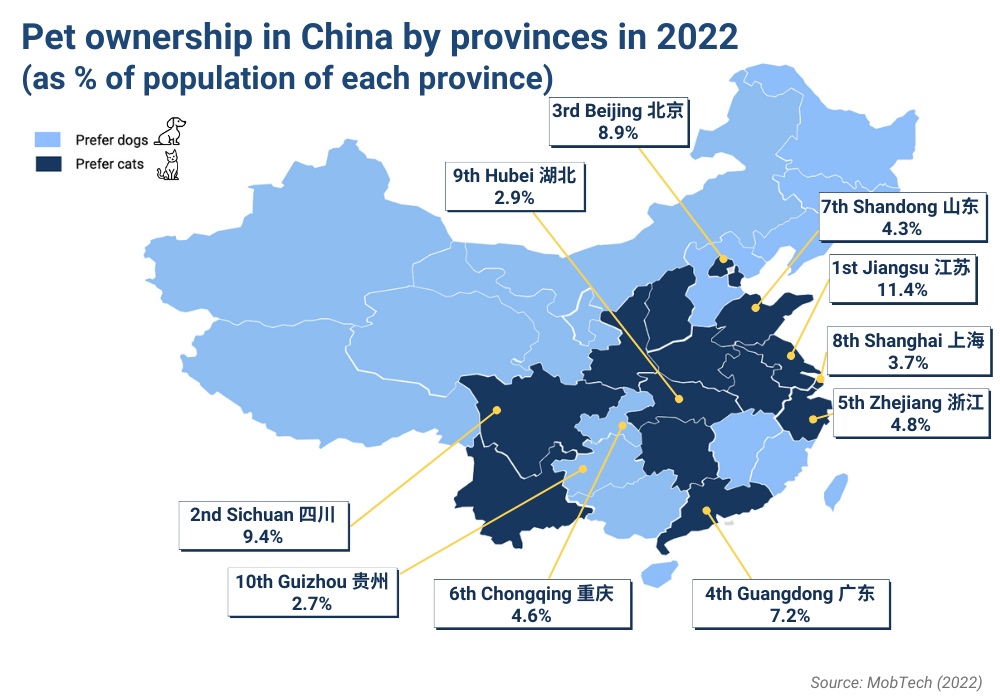
Pet ownership in China is growing as people seek companionship and stress relief. The top 10 provinces for pet ownership are located in the southeast region of China, where the high-net-worth population resides. Residents in Tier-1 and new tier-1 cities prefer cats due to their low-maintenance nature, while those in tier-2 or tier-3 cities tend to have more time for dogs.
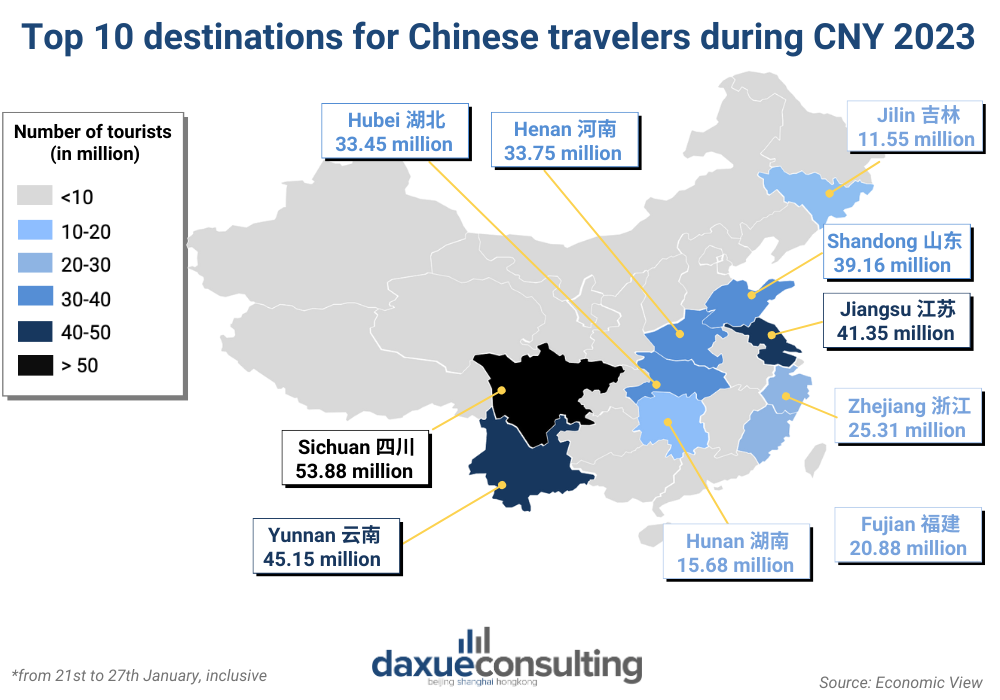
About half of the popular destinations coincided with most of the provinces with a higher number of diaspora workers such as Henan, Anhui, Hunan, Jiangxi, Sichuan, Shandong, and Jiangsu. The residents who work in other provinces took the opportunity of the long holiday break to return home and celebrate the first CNY free from COVID-19 restrictions.
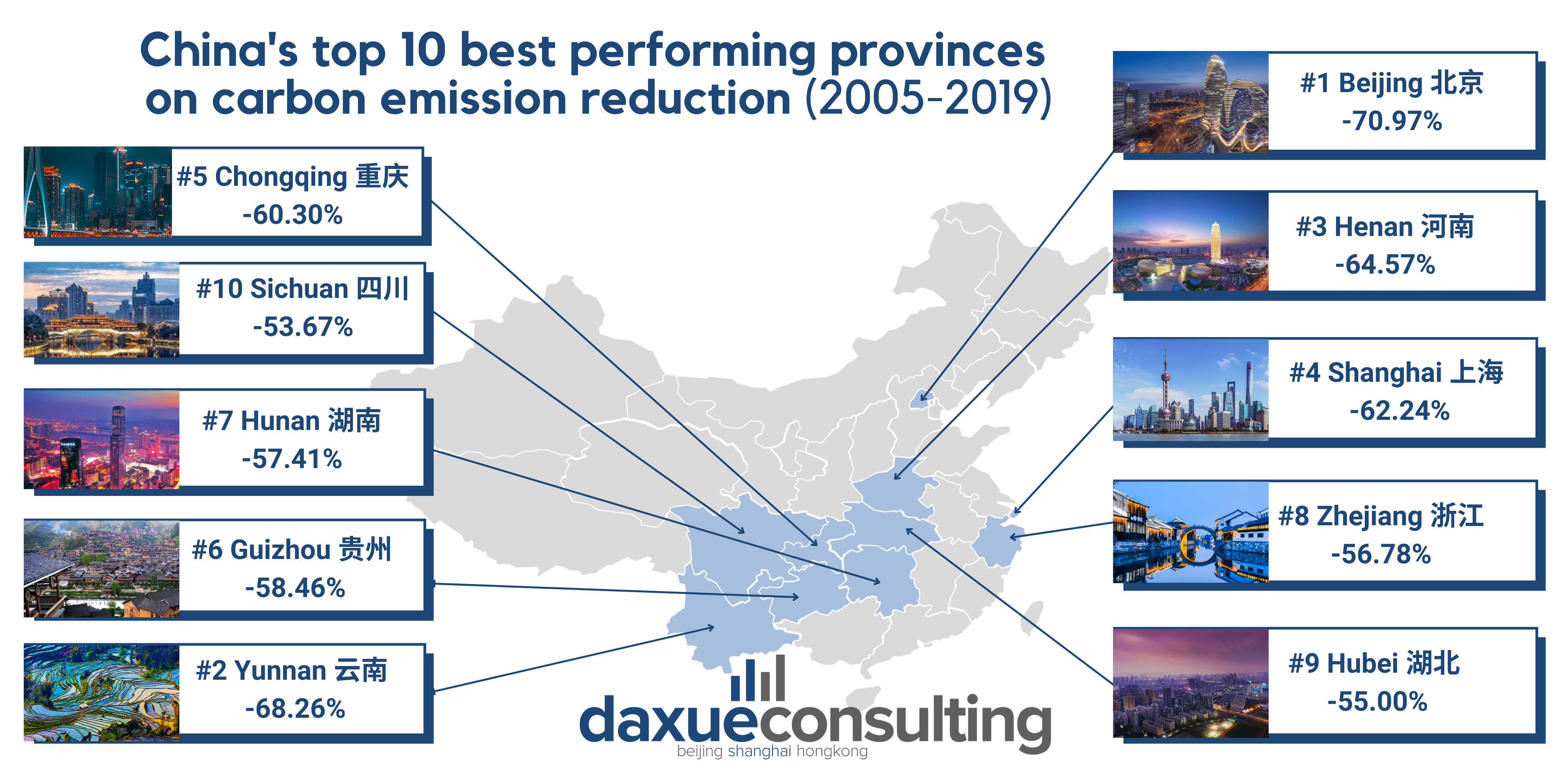
Achieving the peak of carbon neutrality is an inherent goal in China. Between 2005 and 2019, many provinces in China significantly decreased their carbon emission. This map showcases the top ten best-performing provinces in China that have reduced their carbon emissions.
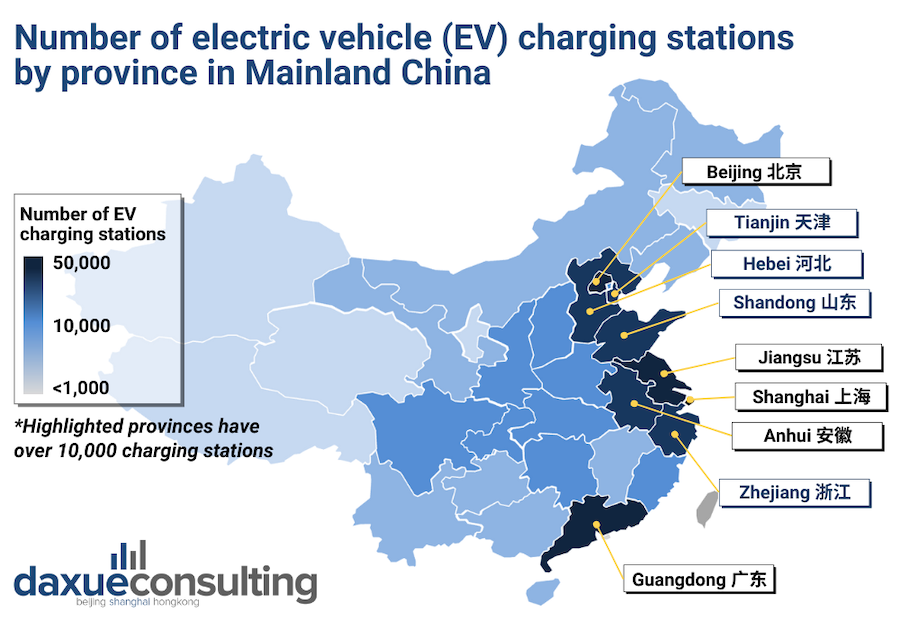
In recent years, the electric vehicles (EVs) industry in China has grown to become a global leader. EVs are sure to become more widespread among consumers, but their success relies on the availability of EV infrastructure. This map displays the number of EV charging stations by provinces in mainland China, indicating which regions in China are ready for the large-scale adoption of EVs.
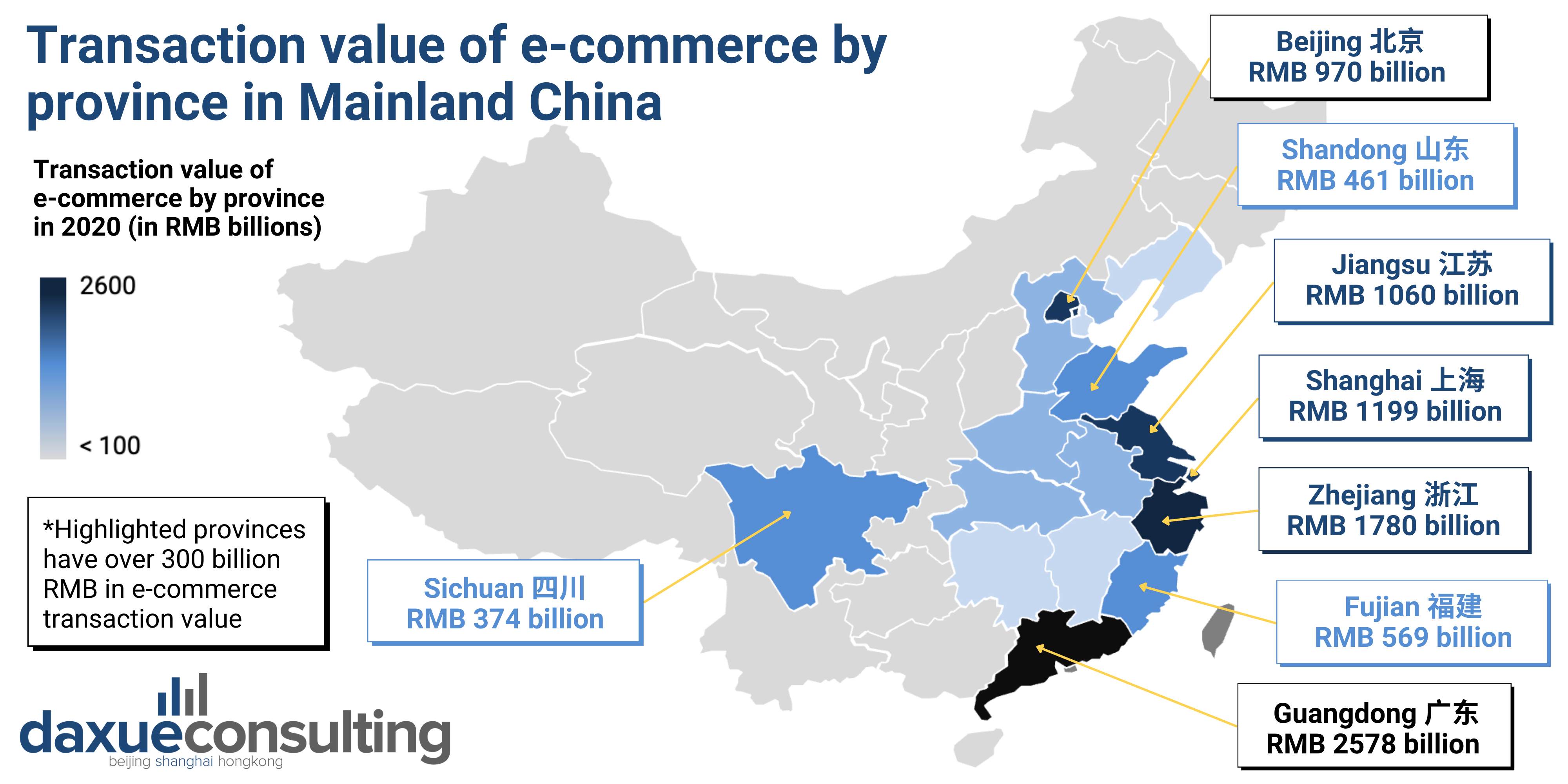
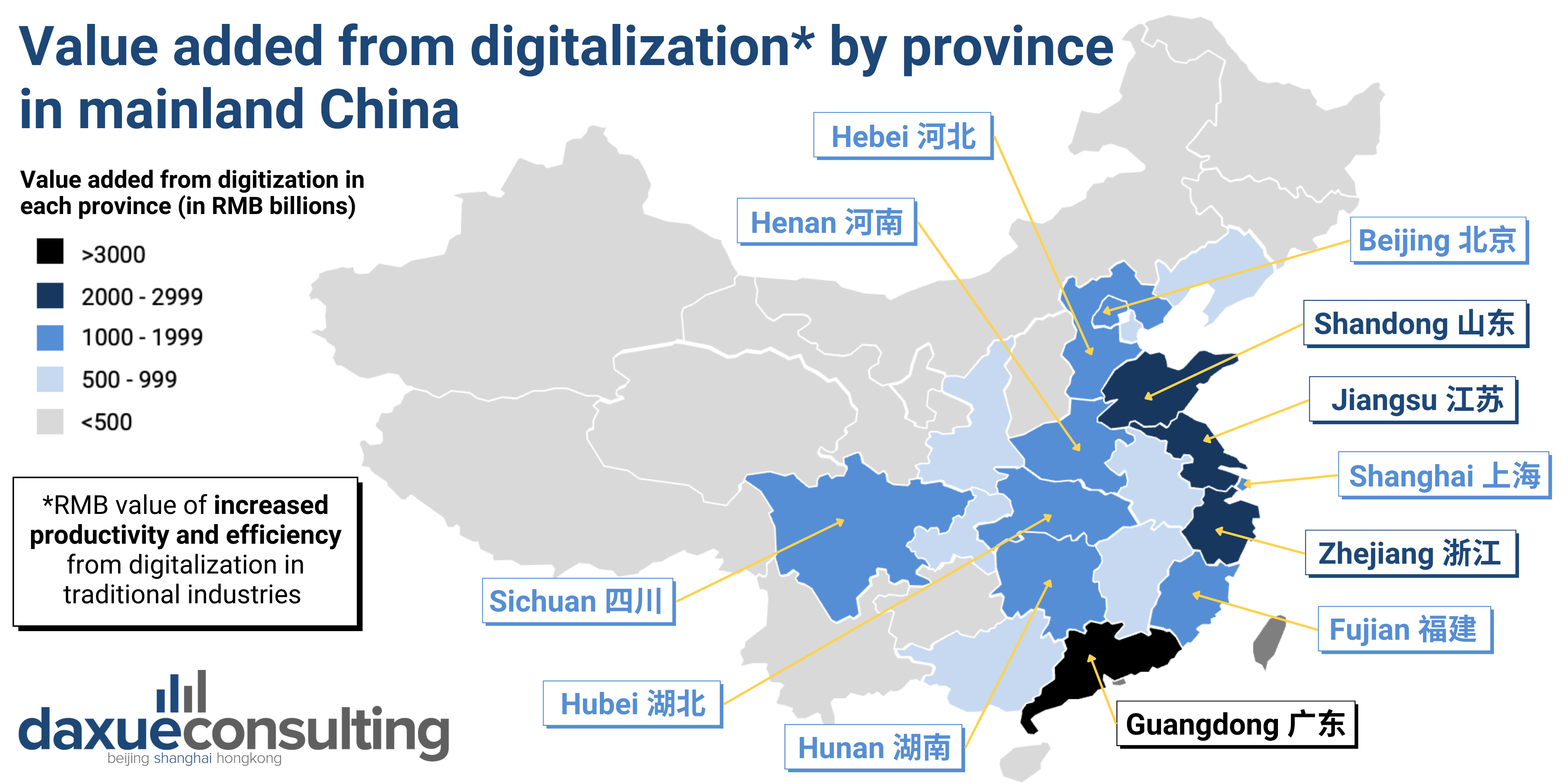
China is the largest e-commerce market in the world, generating almost half of the world’s transactions. In 2020, the total transaction volume of e-commerce in China reached RMB 11.92 trillion. The top platforms in China’s e-commerce market include Alibaba’s Taobao and Tmall (50.8% of market share), JD (15.9%), followed by Pinduoduo (13.2%), which has recently overtaken its competitors and become the third-largest platform. This map reveals the top provinces in Mainland China of e-commerce transaction value, with Guangdong and Zhejiang ranking at the top in 2020.
Today, China is one of the world’s largest investors and adopters of digital technologies. The country has 42% of global e-commerce and transacts 11 times more mobile payments than the United States. Over the years, the Chinese government has enabled digitization by continuing to be a major investor in, and consumer of, digital technologies. This map exhibits the top provinces in mainland China of value added from digitization that has increased both productivity and efficiency in traditional industries.
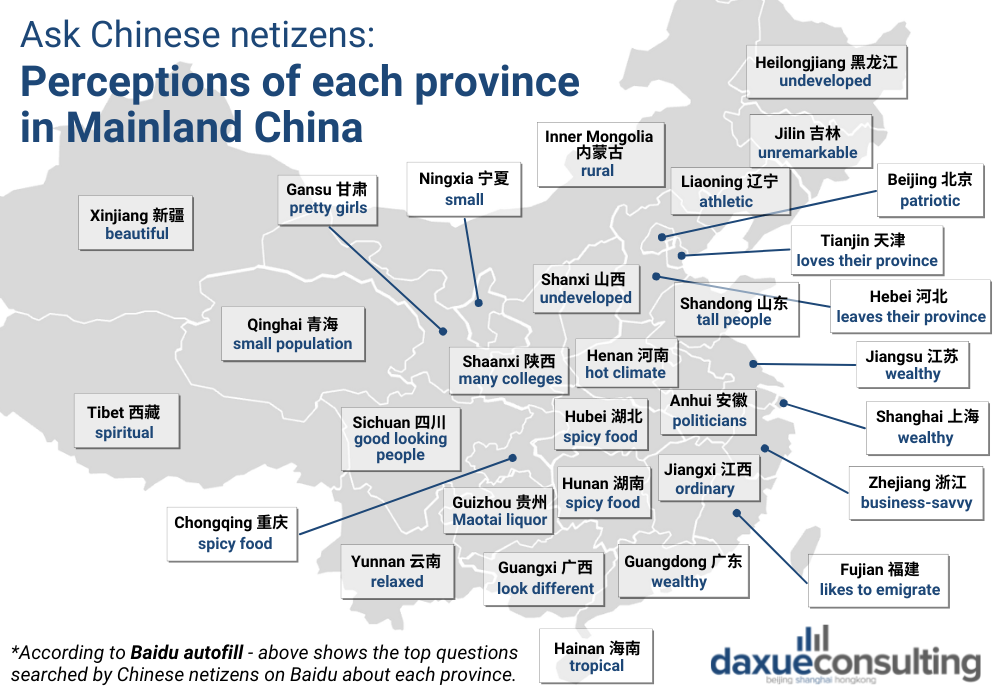
Baidu autofill is based on top searched results on Baidu. Find out about the opinions of Chinese netizens about each province, autonomous region, and municipality in Mainland China. Many perceptions are positive, others are well-known, and some are downright unusual, but they all reflect each region’s unique culture.

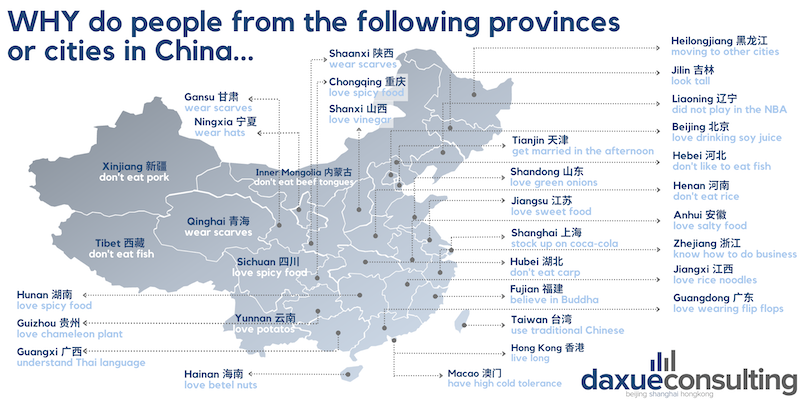
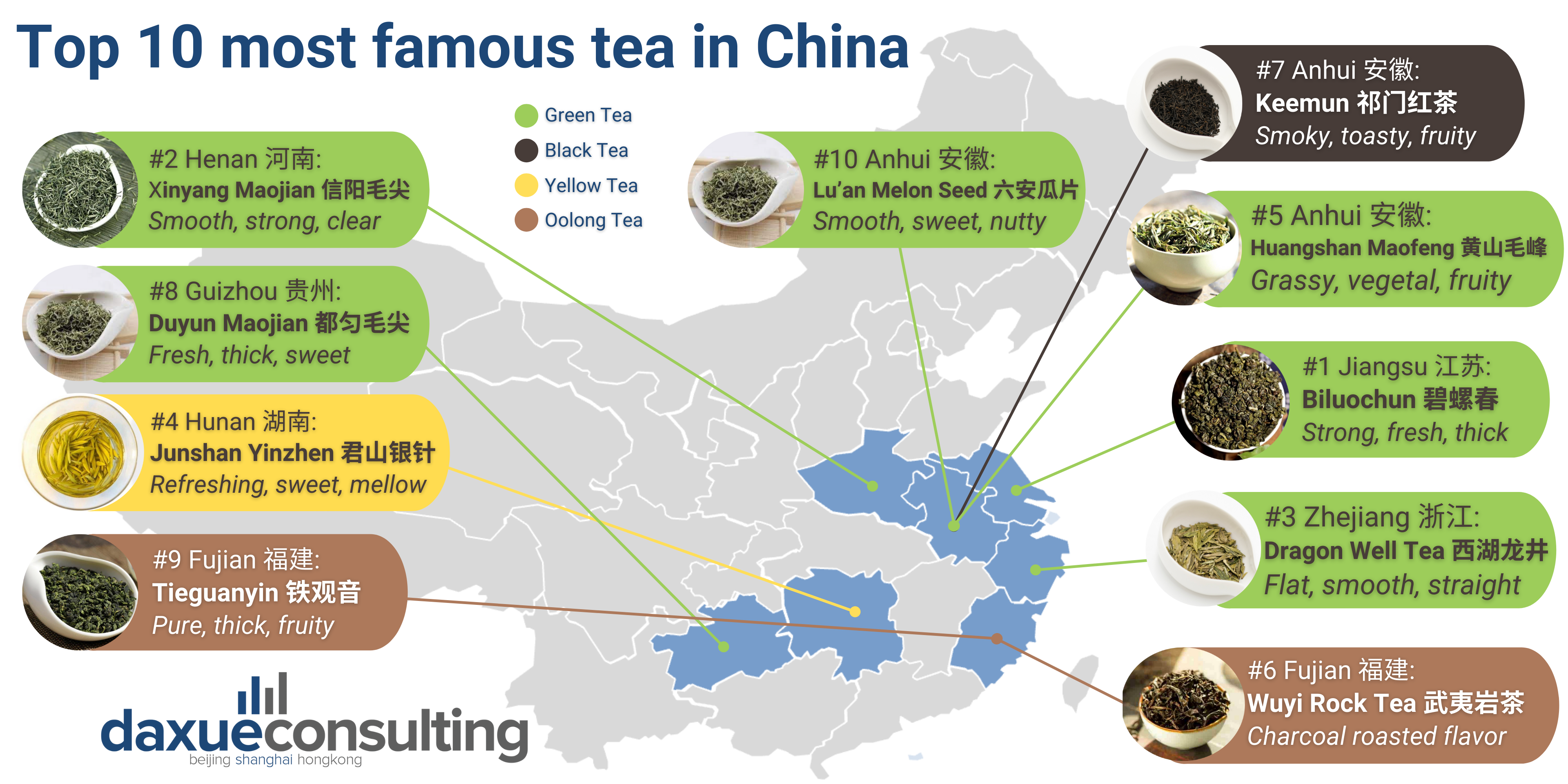
Tea is one of the quintessential cultures of China, with its history being as long as the country itself. A beverage to quench thirst, tea in China embodies the spirit of clearness, respect, joy, and truthfulness. The main varieties of Chinese tea are categorised as green tea, black tea, yellow tea, and Oolong tea.
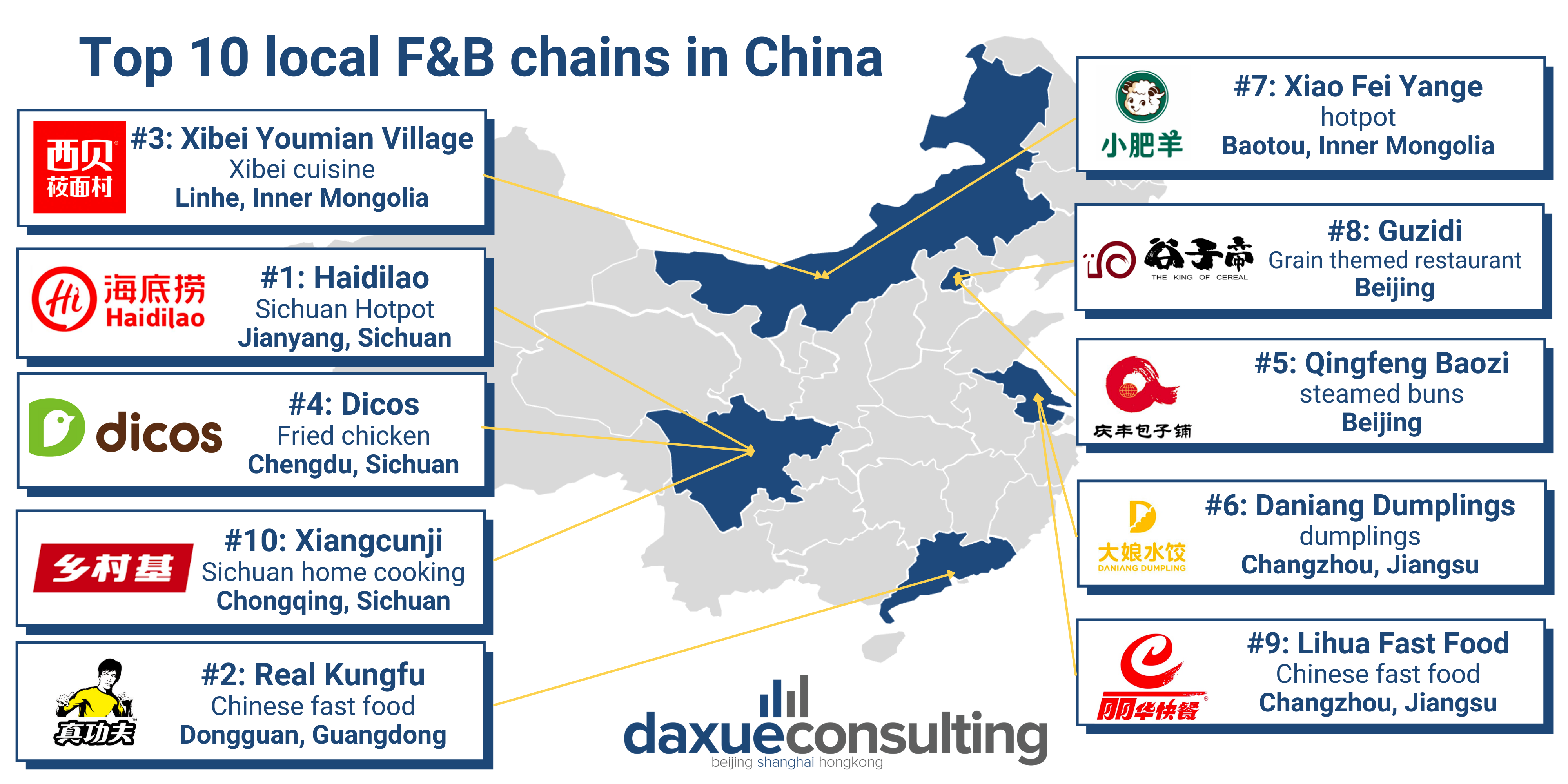
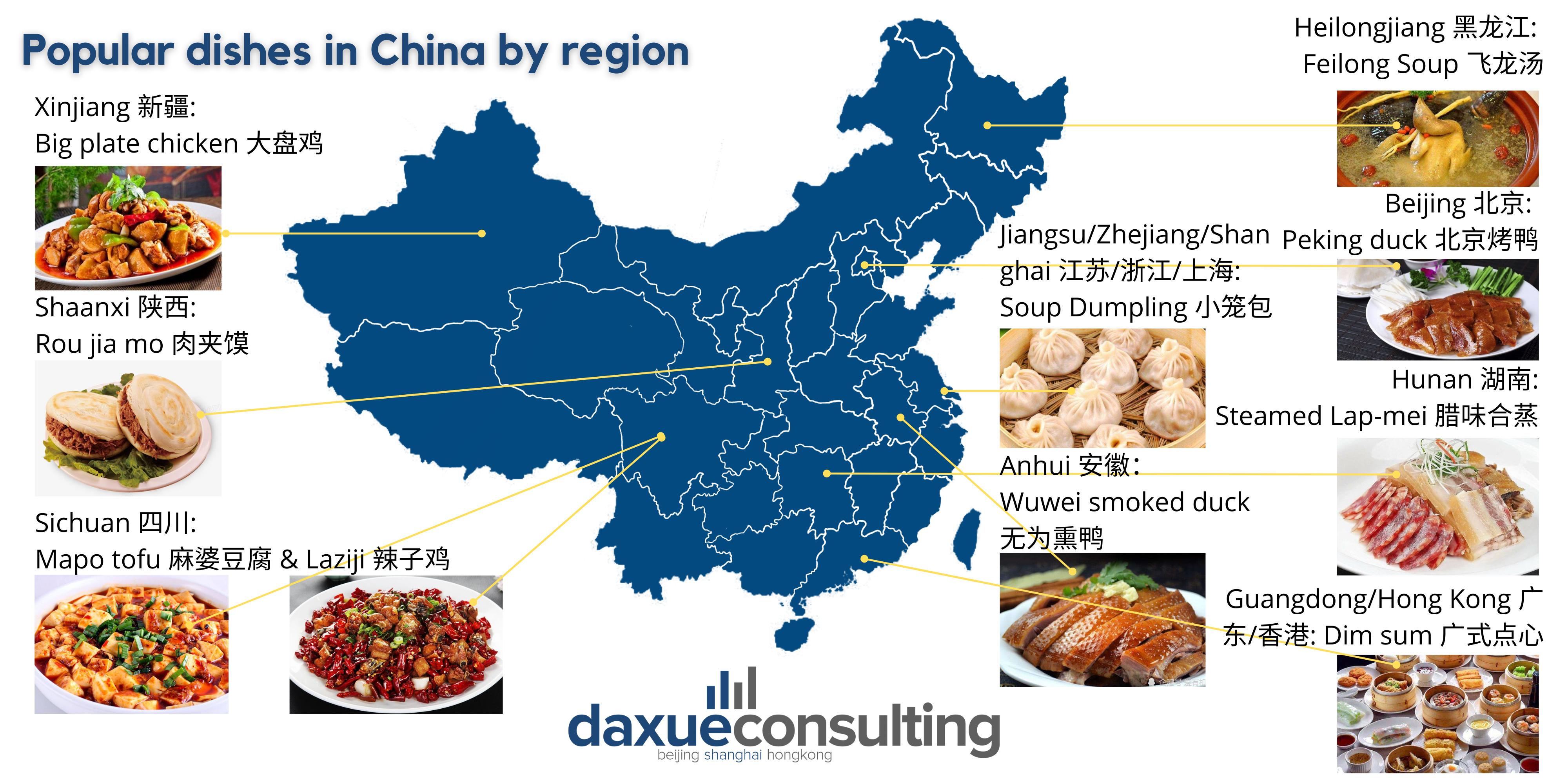
With over 30 provinces in China and 8 major culinary cuisines, food is one of the most imperative elements of Chinese culture. From Anhui, Cantonese, Fujian, and Hunan, to Jiangsu, Shandong, Szechuan, and Zhejiang. Above maps shows the top local food and beverage chains in China and popular Chinese dishes by provinces.
Sichuan is…
- The second largest of the Chinese provinces.
- One of the country’s major provinces in terms of population, resources, economic development, and technological advancement.
- A major production area for lithium-ion batteries.
- The home to more than 30% of the world’s giant pandas
Sichuan has…
- Completely integrated industrial sectors producing high-quality machinery, electronics, metallurgical products, chemicals, building materials, foodstuffs, and silk.
- Chengdu Shuangliu International Airport, it is the fourth-largest airport in China. It’s a modern airport with all the facilities and functions.
- The heart and nerve centre, the Sichuan Basin area, also called the Red Basin (Hongpen), from economic, political, geographical, and historical points of view. Some consider this region to be China in a microcosm, and often as a country within the country.
- One of the most diversified ranges of ethnic groups in all of China, including Han (Chinese), Yi (Lolo), Tibetans, Miao (Hmong), Tujia, Hui (Chinese Muslims), and Qiang.
Henan is:
- the third most populated province in China, after Guangdong and Shandong
- a major wheat and cotton-producing province
- a province with a growing variety of heavy industries, such as chemical works and tractor plants, and light industries, such as the production of textiles, appliances, and electronic equipment.
- an important junction in China’s railway system. Zhengzhou is at the junction of China’s two greatest trunk railways, the line running from Beijing to Guangzhou and the Longhai line, which runs from the east coast to Xinjiang, in the far northwest.
Henan has:
- hydroelectric power from the Sanmen project supply burgeoning industries in Zhengzhou, Luoyang, and Kaifeng
- been deluged by unusually slow-moving rain storms the past week, displacing hundreds of thousands of people and causing 1.22 billion yuan (about $190 million) of economic damage.
Zhejiang is…
- One of the smallest province-level political units of China, but it is also one of the most densely populated and affluent.
- One of the leading provinces in China in terms of farm productivity.
- A leader in tea production and fishing.
Zhejiang has…
- The “double eight strategy” that identifies Zhejiang’s eight strengths in terms of economic structure, geological position, coordinated development of urban and rural areas, ecology, mountain and ocean resources, environment, and culture.
- 22 national-level economic development zones.
- 8 airports including Hangzhou Xiaoshan International Airport which is one of China’s 12 main airports.
Shandong is…
- China’s pivotal cultural and religious center
- one of the richest provinces in China
- the second-largest consumer market (in terms of retail sales) after Guangdong. Retail sales of consumer goods reached RMB 3,577.1 billion in 2019 (8.7% of China’s total)
Shandong has…
- a well-developed rail network system comprising the Beijing-Shanghai Railway, and the Beijing-Kowloon Railway
- 8 civil airports and seven seaports, including Qingdao Port
- major exports comprising machinery, electronics, textiles, garments, chemical products, plastics and related products, base metals, and related products
Jiangsu is…
- an important IT manufacturing base in China that focuses on the development of new and high technology products
- partnering with Singapore through the China-Singapore Suzhou Industrial Park (SIP) and Singapore-Nanjing Eco Hi-Tech Island (SNEHTI) project. Singapore companies continued to show strong interest in Jiangsu province, with 10 commercial projects signed at the 14th Singapore-Jiangsu Cooperation Council (SJCC) meeting (2020)
Jiangsu has…
- the volume of the digital economy reached four trillion RMB, accounting for over 40 percent of the province’s GDP (2019)
- the export value of electronic products amounted to 1,796 billion RMB (or 66 percent of total export value). Major export markets included the United States, Japan, and South Korea (2019)
- It’s GDP increased by 3.7 percent to reach 10.27 trillion RMB in 2020 despite the COVID-19 pandemic
Guangdong is…
- The most populous province of China and the 15th-largest by area (179,800 km²)
- The province with the largest economy in China
- The world’s 4th largest sub-national economy with a GDP of 10.77 trillion RMB (2019)
Guangdong has…
- The Pearl River Delta Economic Zone, a Chinese megalopolis, is a core for high technology, manufacturing, and foreign trade
- 14 enterprises from Guangdong got in Fortune Global 500: Ping An Insurance of China, Huawei Investment, Zhengwei International, China Southern Power Grid, Country Garden, etc. (2020)
- 71 enterprises from Guangdong were in the Top 500 Enterprises of China (2020)

